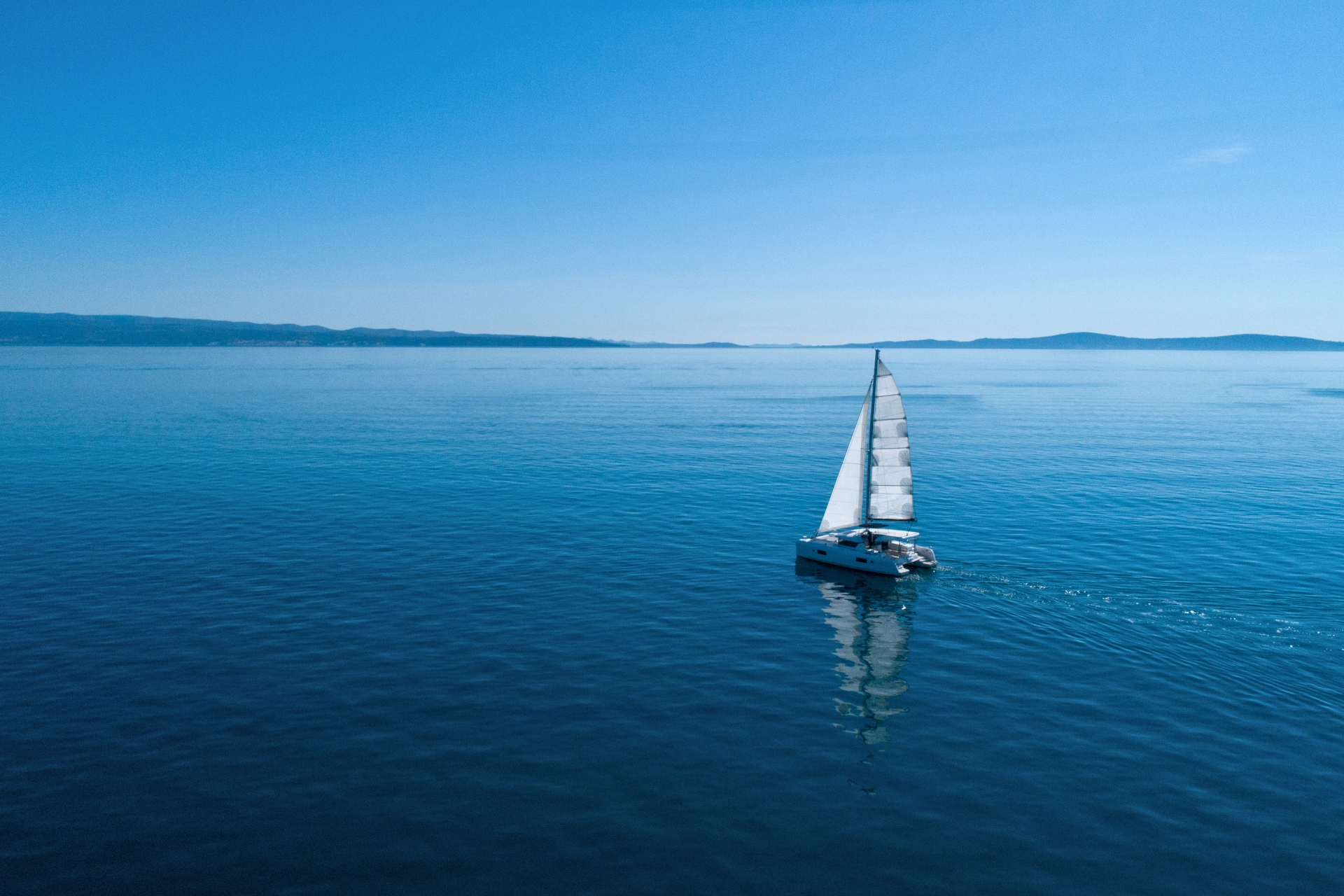Tips for First-Time Sailors in Croatia You’ve decided to go sailing for the...
Read moreFirst Time Sailing? No Worries, We Got You Covered!
10 Things to Know About Yacht Charter
Shopping in Rogoznica
Shops, markets, working hours in Rogoznica – where to supply for your charter
Navigating Croatian Waters – Sailing Licenses
History of X-Yachts
Fishing in Croatia
The rich waters of the Adriatic are perfect for passionate fishermen!
Sailing the Adriatic: How Winds Impact Your Cruise
Are you ready to go sailing in the Adriatic? Read to learn more on the Adriatic winds, currents, and weather in general.
A Dreamy Escape to Reality: Charter Lagoon 51
A Day on Board a Crewed Yacht in Croatia
Cooking on a Boat? What to Cook + a 7-day Menu
Read our suggested 7-day meal plan for cooking on boat. Download our free meal planner and shopping list
Finding the Best Boat Name
Sailing Alone on the Adriatic Sea
Tips for First-Time Sailors in Croatia
You’ve decided to go sailing for the first time on your vacation. Well done! Whether you’ve been invited as a guest or are organizing the trip yourself with family or friends, it’s an exciting way to spend your vacation. However, before you step onboard, there are a few essential tips that can help you prepare for your first sailing adventure. Let’s go over the most important ones together.
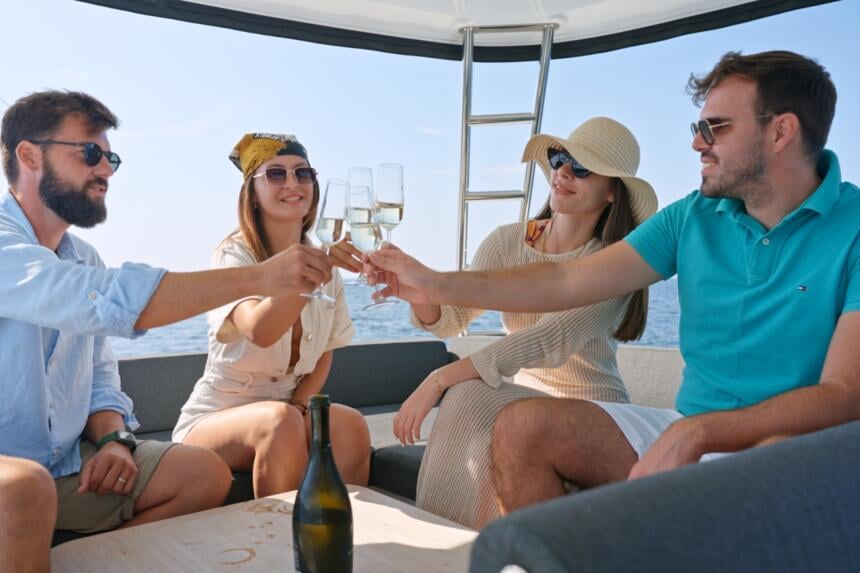
Packing Light and Smart
Staying on a sailboat is a unique and luxurious experience, but when it comes to space for your belongings, don’t expect the same. Each cabin has only a few closets and drawers, so it’s important to plan ahead and pack your clothing carefully. If you’ve ever been camping, you have an idea of how much stuff you need and how limited the space can be. It’s the same with sailing boats. Also, another thing to have in mind is the weather. As they say, there is no such thing as wrong weather, only wrong clothing.
Tips for packing:
- Lightweight, quick-drying clothes – T-shirts, shorts, and moisture-wicking fabrics.
- Swimsuits – Bring a few options for days spent swimming and sumbathing.
- Hat and sunglasses – For sun protection.
- Windproof jacket – Essential for cooler evenings and windy conditions.
- Sweatshirt or fleece – In case it gets chilly at night.
- Non-slip boat shoes – Important for safety on deck.
- Flip-flops or sandals – For easy wear when onshore.
- Comfortable evening clothes – For dining or exploring towns.
- Waterproof gear – If rain in the forecast, a waterproof jacket and pants can be helpful.
- Light scarf or sarong – Versatile for sun protection or covering up.
Sunprotaction is a must
In addition to packing clothes, it’s also important to think about packing cosmetics and medicine. The same rule applies as with clothes—keep things to a minimum, but some items are essential. As the title suggests, sunscreen is a must since you’ll be spending most of your time outdoors. No matter the time of year, the sun can be harmful without proper protection.
Here’s a list of cosmetic products you should bring along:
- Sunscreen (high SPF, water-resistant)
- Lip balm with SPF
- Moisturizer (for face and body)
- Aloe vera gel (for sunburn relief)
- Shampoo and conditioner (in small travel sizes)
- Biodegradable soap/body wash
- Deodorant
- Toothbrush and toothpaste
- Wet wipes (for quick freshening up)
- Hand sanitizer
- Hairbrush or comb
- After-sun lotion for hydration
Some recommended medicines and supplies to include are:
- Paracetamol: Effective for pain relief and reducing fever.
- Ibuprofen: Helps with pain, inflammation, and swelling.
- Cough syrup: Useful for soothing a sore throat or mild cough.
- Nose drops: Helpful for nasal congestion, especially in dry or windy conditions.
- Eye drops: Ideal for irritation caused by saltwater, wind, or sun exposure.
- Medicine for seasickness: Essential for preventing nausea and doscomfort while on the water.
- Antihistamine cream: Great for treating mild allergic reactions, insect bites, or skin irritations.
- Medicine for diarrhea: Important for managing gastrointestinal issues, which can happen due to unfamiliar food or water changes.
Read our full blog on packing tips along with a downloadable PDF in our packing tips blog.
Anticipate Seasickness
Anticipate the possibility of seasickness, but don’t be afraid of it. What does this mean? There are steps you can take to reduce the likelihood of seasickness, which we will outline here or read our full blog on the topic of seasickness. However, our goal is not to alarm you in advance, especially if you haven’t thought about this before. Keep in mind that if you worry about getting seasick, you are more likely to experience it. Therefore, we recommend a relaxed approach, with an awareness of the possibility and a few tips to improve the situation.
First and foremost, arrive on the boat well-rested and refreshed. If you have the opportunity to spend the night on the boat before sailing, that’s even better. You’ll be able to adjust more easily to the upcoming conditions. Also, avoid certain foods that contain histamine, such as fermented foods (aged cheese, wine, and sauerkraut), processed meats, smoked fish, vinegar, and certain vegetables (like tomatoes and eggplants). One food that is believed to help alleviate symptoms is ginger, although there are no studies that clearly confirm this. If other crew members allow it, choose a cabin in the middle of the boat, as these tend to sway less. Additionally, cabins with windows are a much better option than those without.
Prepare your groceries
If you haven’t hired a chef during your stay on the boat, food is one of the points you should consider before boarding. Whether you are the person in the group taking on this responsibility or if several of you are deciding together, consider the number of passengers, the number of meals, and the planned route. Our advice is to stock the refrigerator before setting sail from the marina so that this task doesn’t weigh on your mind. If you plan to make stops in populated areas, that’s a good opportunity to restock your supplies. We’re not saying it’s a major issue, but it is definitely something to think about and plan ahead for in agreement with the entire crew. Anyway, we assume you will also visit some local restaurants along the way. For further research: other blogs might come in handy – 7-day menu on board or how to cook like a pro on board, boat supply in Split & boat supply in Rogoznica.

Plan the sailing route ahead
When you rent your sailing boat, you have complete freedom to choose where you will sail during your trip, where you will spend the night, where you will anchor, and when you will set off. However, it is not advisable to think about your travel route once you set sail. Do this in advance. Research the area, consider everyone’s interests, and choose a route that suits your style (check out our sailing routes). Finally, if you want to avoid the stress of planning your route for the first time sailing experience, navigating restricted marine zones, and dealing with docking issues, we recommend hiring a skipper. This will certainly help you relax and make the most of your vacation.
Be humble with water consumption
Another thing to be aware of before your first sailing experience is water consumption. The freshwater capacity is limited. Boats are equipped with one or two water tanks, and you can only refill the tanks in a marina or harbor. It’s used for showers, food preparation, and washing dishes. Most larger boats/yachts also have watermakers and this gives you more flexibility on your sailing route.
Therefore, be cautious with your usage. You don’t always have to take a full shower; rinsing just your face and hair might be enough or use the stern shower to reduce water usage. For drinking, don’t use the water from the water tanks. Equip the boat with enough bottled water, as even unboiled tank water may cause stomach issues. While you can refill tanks at marinas along the way, it’s definitely advisable to be humble with your water usage.

Toilet use
One of the most important things to pay attention to for first-time sailors is the use of the toilet. As an adult, you may think you know everything about using a toilet by now; however, the toilet on a boat has its own specificities. These specifics can vary from boat to boat, and the best advice is to ask the marina crew how to use it. However, some general advice is that you should not throw the following into the toilet: toilet paper, (wet) wipes, sanitary pads, food scraps, and anything else that could clog the pipes. This is very important to remember because, besides not being able to use the toilet during your trip, unblocking services incur additional charges. Read one of our most popular blog posts on the topic – how to save 300 EUR.
Proper behavior on board
Although this will be your first time sailing experience, we believe you are already aware of certain details related to staying on a boat. The deck can be slippery, and running is generally not recommended. Move cautiously while sailing and use handrails to avoid risks.
Wear appropriate footwear, preferably with non-marking rubber soles or at least shoes with white soles to avoid leaving marks on the boat. Additionally, space on the boat is limited, which means you should be considerate of others’ privacy. Keep in mind that not everyone’s the same; some people may enjoy solitude, reading a book, listening to music, or simply soaking in the beauty of the horizon without wanting to be disturbed. On the other hand, it’s important to be aware of your behavior. Boats are not soundproof, and your movements and conversations in the cabin can easily be heard, which can disturb other passengers, especially at night.
None of these tips are rocket science, but as you can agree, they are worth keeping in mind!
New to Yacht Charter? 10 Things Our Base Manager Wants You to Know
With 35 years of experience as a leading yacht charter company in Croatia, Nautika Centar Nava, has worked with plenty of clients. We’ve engaged with professionals, amateurs, sailing aficionados, and travelers, alike. And we have noticed some patterns and misconceptions about charter in Croatia. In particular, in regard to the check-in procedures, boat embarking, and charter start.
As official dealers for Lagoon, X-Yachts, and Beneteau, among other brands, Nava Boats knows a thing or two about successful yacht charters. Our base managers and booking agents in Split and Rogoznica are ready to welcome you aboard. However, before you arrive, here are a few things we’d like you to keep in mind to ensure a smooth and enjoyable sailing experience:
#1 – It Takes Time to Prepare a Boat
Please be patient as we prepare your boat for your arrival. It takes a few hours to clean and inspect the vessel. The amount of time for completing these tasks can vary depending on the condition it was left in by previous guests. We’re committed to handing over the boat in the best possible condition, so you can have a fantastic sailing experience.
If you’re in a hurry, you can request a VIP-Fast Track Check-In for an additional fee of 200 € and embark at 2:00 PM instead of the standard 5:00 PM. With this extra fee we hire additional staff and make sure the boat is in superb condition. Important remark, we cannot guarantee VIP-Fast Track Check-In in advance. We charge it once we confirm it to you directly on the day of charter start.
#2 – Do Your Research (especially) if You’re Renting Bareboat
If you’re renting a bareboat and haven’t sailed on the same boat type before, we recommend doing some research and preparing your questions in advance. This will help you feel more confident and prepared for your sailing adventure. We recommend watching our Check-in procedure video on the Lagoon 42 since most of it can be applied to other models as well.
We also recommend watching Green Sail’s introduction to charter in Croatia. Apart from tips for sailing more efficiently and sustainably there are some useful tips in general.
#3 – Prepare Sailing Route in Advance
It’s a great idea to plan your sailing route ahead of time (find inspiration on our sailing route page) and ask for advice during check-in. If you have a skipper, create a list of destinations you’d like to visit. However, be sure to listen to their advice regarding weather, safety, and sailing distances. Remember that sailboats and catamarans typically travel at around 8 nautical miles per hour on engines, so visiting multiple distant destinations in one week might not be feasible.
#4 – Check-In Can Take Time
The check-in on board, the actual handover, can take anywhere from 20 to 45 minutes, depending on your individual needs and requirements. By preparing for the charter and getting to know the boat beforehand, you might speed up this procedure significantly.
#5 – Send in Your Crew List
Please send us your crew list with all the required details before you arrive. This will help simplify and rush the check-in process and ensure a smooth start to your charter.
#6 – Shop for Provisions
You can either shop for provisions near the marina in Split, or even in the marina in Rogoznica (very pricey and limited offer), or do it on your way to the marina. By far the most elegant way is to order provisions in advance. Contact us if you’re interested in this option. This will save you a lot of time and effort (carrying bulky items and the many bags or boxes of groceries). Our partners deliver everything on board and even put away food that needs to be in fridges. This way you’ll have everything you need to start your trip.
#7 – Define Additional Services and Water Toys
Let us know if you’d like to have any water toys on board or require additional services like transfers or child netting. We’ll do our best to accommodate your requests.
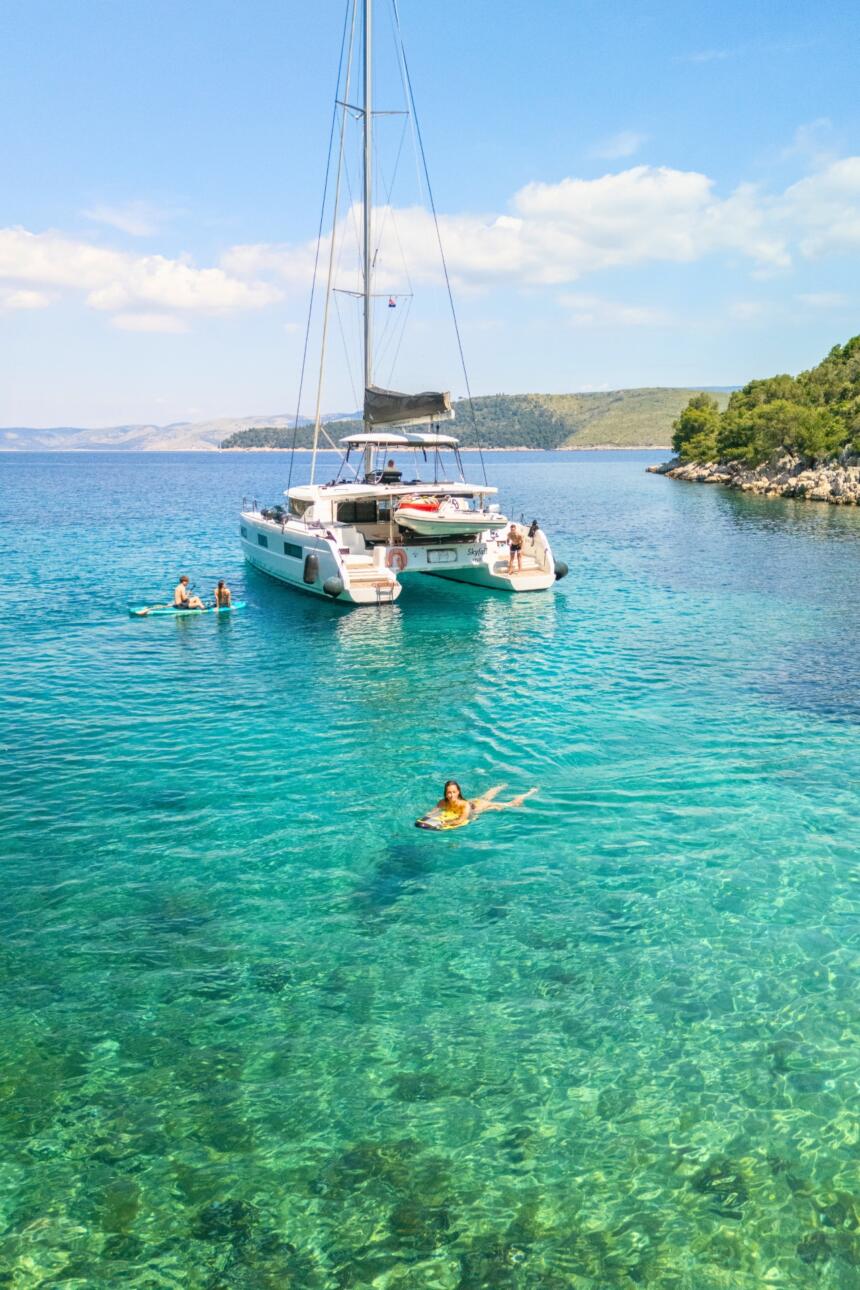
#8 – Be Prepared for Marina Frapa’s Trolley Situation
Please note that Marina Frapa doesn’t allow us to have our own trolleys. You’ll need to be quick and grab a red trolley as soon as you see one and return it to the roundabout after use so that others can use it as well.
Additionally, we can’t use electric vehicles to transfer luggage to the docks due to the narrowness of the transit pier.
#9 – We’re All Human
Weekends can be especially busy and hectic, but we always strive to deliver the boats in the best possible condition and at the earliest time possible. We appreciate your understanding and patience.
#10 – Brief your Crew or Listen to your Skipper
If you are renting bareboat make sure to brief your crew before you sail out. Especially if some of the crew are first-time or inexperienced sailors. Show them how to use the toilets to avoid paying for the blocked toilet damage (learn all about that in our previous blog on how to save 300 € by avoiding to block toilet(s)), or any other appliances on board. Assign tasks to each crew member, or let them choose – lookout, buoy “grabber”, docking assistants, stewardess, etc. and explain each role. If you hire a professional skipper make sure to adhere to his/her advice and safety requirements.
Smooth Sailing and Anchors Aweigh
By keeping these tips in mind, you’ll be well-prepared for a seamless and unforgettable yacht charter experience with Nava Boats. We’re excited to welcome you aboard and help you create memories that will last a lifetime. Contact us today if you still have some questions or to book your dream yacht charter and start planning your Adriatic adventure!
How and Where to Supply Your Boat – Shopping in Rogoznica
As you prepare for your charter trip, it’s good to find more information on where and how to supply your boat.
Ordering provisions in advance is always a good idea, as this will save you time. This is certainly one of the best options if you’re flying in, especially if you have a late flight. Contact our charter team if you’d like to order some or most provisions through our partners. They’ll deliver the selected groceries on board and even put away those that need to be stored in a fridge or freezer before you arrive to the boat.
You can buy other groceries on your way in, or before you embark on your yacht. If your selected boat charter is starting in Rogoznica read on because you’ll find some useful info on where you can supply your boat in Rogoznica. If you’re starting from Split, head on over to our previous blog on where to supply your boat in Split.
We recommend buying for 2-3 days in advance as storage space on board is limited.
Shops and shopping in Rogoznica
Rogoznica is a smaller town compared to Split, for example, however, it’s a tourist spot so there are still plenty of options. There are several mid-sized shops in Rogoznica town centre, one large market Tommy at the entrance to Rogoznica and a big supermarket, Plodine, just outside Rogoznica. If you’re in need of a proper, well-equipped shop, stopping by Plodine before you get to marina would be a good choice. Bear in mind, Croatia has recently introduced new legislation on Sunday working hours. Shops can only be open on 16 Sundays per year, make sure to check the websites ahead of shopping. Read more in our blog on public holidays and working hours. In very touristic locations such as Rogoznica, most shops will opt to work every Sunday during high season, but it still might be a good idea to check before you go to the store.
Studenac
- Jadranska 7a, 22203 Rogoznica
- Monday to Saturday 7:00 – 20:00
- Sundays – check the official website for working hours
- Ulica Ante Starcevica 18, 22203 Rogoznica
- Monday to Saturday 7:00 – 20:00
- Sundays – check the official website for working hours
Tommy
- Ulica Ante Starcevica 78, 22203, Rogoznica
- Monday to Saturday 7:00 – 21:00
- Sundays – check the official website for working hours
Plodine
- Podvornica 1, 22203 Rogoznica
- Monday to Saturday 7:00 – 22:00
- Sundays – check the official website for working hours
Additional shopping options in Rogoznica
Fish market
- Monday to Sunday – 6:00–13:00 (depending on the daily stock)
Green market – locally known as Pazar
- Monday to Sunday – opens at 7:00
Both fish market and green market are situated just next to the next to causeway to the historical part of Rogoznica. A Studenac shop, stands and a bakery are also on this site – Jadranska 7a Street. The availability and diversity of the products are highly dependent on the season and the success of fishermen. It is important to note that both markets do not have specific working hours similar to a regular shop or a store. They function based on the daily stock and how fast it sells. Keep in mind that working hours may vary daily. We suggest hitting the markets early in the morning so you have a bigger selection to choose from.
Marina Frapa Resort Rogoznica – lots of shopping options
Marina Frapa Resort Rogoznica is an award-winning marina, with 15 awards as the best Croatian marina. The marina is situated just outside the Rogoznica town centre.
This modern equipped resort includes:
- hotel and marina reception with an exchange office
- café, bars and a nightclub
- two restaurants, one of which is a sushi bar
- several small shops and boutiques with souvenirs, nautical/fishing gear and nautical clothes and beachwear and similar
- a small shop with basic supplies – KONZUM. This shop is open even on Sundays and holidays since it’s located in a marina. However, the prices are on the more expensive side.
- Laundry service
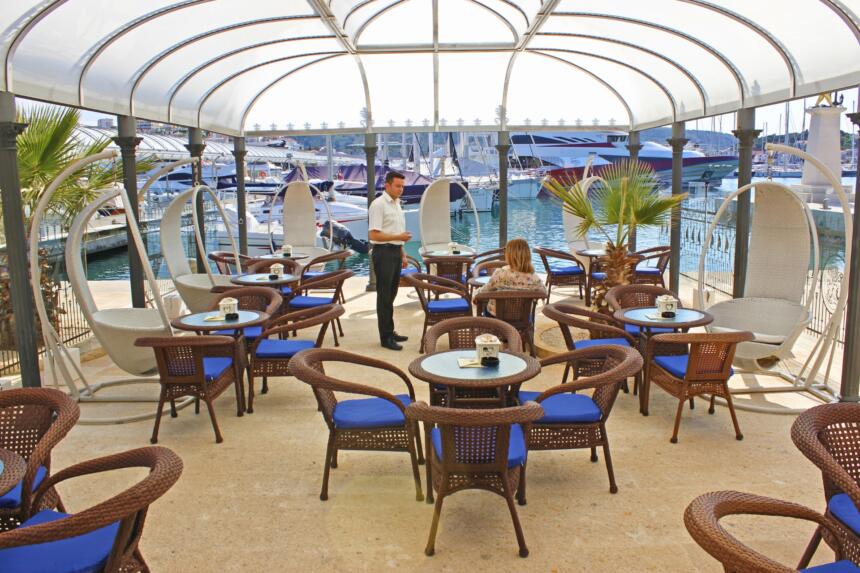
If push comes to shove, the marina has everything you need to supply ahead of your departure.
What to expect on the islands?
When shopping on the islands, you and your crew will never go hungry or thirsty—every village, no matter how small, has a shop stocked with basic supplies for your boat. We also recommend seeking out local green markets and fish markets for fresh, local produce (ask the sailor that assisted you with docking at the port or marina, or inquire at the harbor or marina reception). Keep in mind that while larger chain stores often accept cards, smaller shops may only take cash.
Overall, you’ll find everything you need while cruising in Croatia. Every island offers shops to restock your boat, and charming restaurants are always nearby for a delightful lunch or dinner if you’re out of supplies or simply prefer not to cook. We hope this guide helps you prepare for an unforgettable sailing vacation, and if you have any additional questions, feel free to reach out to our charter team!
It might be a good idea to also get familiar with our check-in process and check-out process ahead of time. So you’ll be prepared to start your summer adventure as smoothly as possible.
What you need to know about sailing licenses in Croatia
Sailing in the pristine waters of Croatia is nothing short of amazing. With crystal-clear waters, stunning islands, and a rich cultural heritage, Croatia is every sailor’s paradise. The excitement of navigating the picturesque coves of the Dalmatian Coast or dropping anchor near historic towns like Hvar, Korcula, or Dubrovnik is a true mix of adventure, relaxation, and discovery. But before boarding your yacht or boat in Croatia and setting off into the shimmering blue, some crucial preparations are in order. The main one is checking if you are legally allowed to sail this piece of paradise by yourself.
Understanding Croatian sailing laws and licenses
Croatia has a set of Maritime laws that every skipper must adhere to for safe and lawful sailing experience. Whether you’re an experienced sailor or new to the sea, understanding these laws can only enhance your boating vacation.
Key regulations include holding a valid license for sailing as well as for operating VHF radio stations. Skippers also need to strictly adhere to navigation rules within territorial waters and respect maritime traffic regulations. Environmental protection standards are non-negotiable too!
Additionally, it’s not just optional, but mandatory to report any incidents such as accidents or emergencies to the Harbor Master’s Office. Compliance with these regulations ensures everyone on board can enjoy incredible sailing experiences with peace of mind.
Safety first: adhering to local rules and regulations
Beyond licenses and local laws, there’s an array of essential safety measures every sailor must follow while cruising through Croatian waters:
- gathering your crew before sailing off for a safety briefing. It’s important to explain to you crew, especially first-timers all that you expect and require from them during navigation, when docking and at anchor. Warn your friends and family about safety rules, their roles, and responsibilities when docking or underway.
- all those aboard should have access to personal flotation devices (PFDs)
- monitoring weather forecasts and paying attention to signal flags can preempt turbulence
- respect maritime boundaries – remember those no-sailing zones marked on your nautical maps!
- always keep a well-stocked first aid kit onboard – check during the check-in the whereabouts of these
- practice line-of-sight navigation whenever possible
Remember – safety isn’t just another box you tick; it’s paramount aboard any vessel!
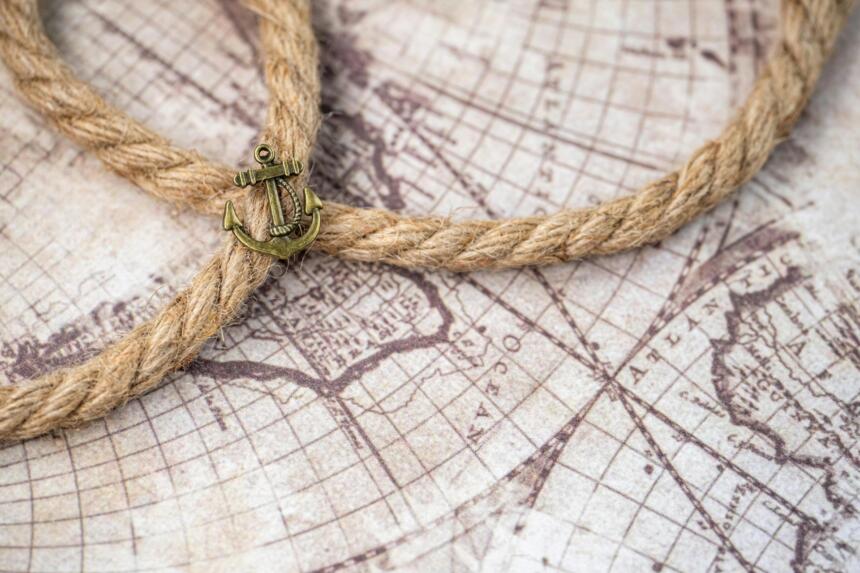
Types of sailing licenses in Croatia
In Croatia, for bareboat charters, you generally need one of two licenses: Nautical License Category C or Category B.
- Category B License: Lets you be in charge of yachts up to 15 meters long. This license never expires but cannot be used for commercial purposes.
- Category C License: Mandatory for professional captains or anyone using a vessel for business. It also covers yachts up to 15 meters but requires renewal every five years.
Boat Manager License Category B – exam
A person qualified to be the skipper of a Category B boat must be at least 18 years old to operate a boat with a propulsion power of more than 15 kW. With this license, you can operate several types of boats and participate in various maritime activities, including personal leisure and commercial transport (with specific limitations).
One can take the exam even at the age of 16, but with 15 kW restrictions in place until the age of 18.
Course content
If you decide to take a course that lasts between 4 and 6 hours, you’ll be perfectly ready to take the exam.
The course covers navigation, basic knowledge of motor repairs and maintenance, maritime law and meteorology, boat maneuvering safety and first aid and maritime radio communication service.
The other option is to prepare for it on your own. This might take a little longer than 6 hours.
The exam is fairly simple and accessible because you can take it at the Competent Port Authority or the Ministry of Maritime Affairs, Transport, and Infrastructure. It’s held almost every week and consists only of theoretical knowledge (written and oral). However, you need to set aside enough time because it takes a few hours to complete it.
The Ministry of Sea, Transport and Infrastructure determines the prices, but the license is valid world-wide and has no time limit.
In order to take the exam, you need the following documents:
- completed form for taking the exam
- two recent photographs 2,5 cm x 3,5 cm
- copy of your ID card and/or passport and the original at hand
- proof of exam fee payment
However, if you’re considering being a professional skipper or using a boat for business, you’ll need the Category C license. This one also lets you handle yachts of over 18 meters, and it requires a renewal every 5 years.
Both of these sailing licenses in Croatia also include the operation of the VHF radio stations.
Foreign Sailors: Recognizing international sailing licenses in Croatia
Great news for international sailors – if you hold a sailing license that the Croatian authorities accept, you can instantly rent most of the boats on the charter market! However, it’s wise to confirm that your license is valid under Croatian maritime law before you venture into the beautiful waters of the Adriatic. Find the full list of recognized licenses by the Croatian Ministry of Maritime Affairs.
For instance, the most common ones are licenses issued by
- ÖSV and MSVÖS, and viadonau since 2012 in Austria
- Uffici delle Capitanerie di porto, Uffici della Motorizzazione civile in Italy
- Deutscher Segel Verband, Deutscher Motoryachtverband in Germany
- Polski związek zeglarski, Polski Związek Motorowodny i Narciarstwa Wodnego in Poland
- Sjøfartsdirektoratet in Norway
- IYT in Canada
- USSA and ASA in the USA
- Institut für Hochseenavigation Schweiz, Luft und Seefahrtschule, Segelschule Rorschach Schweiz, and CCS in Switzerland
- MCA and RYA in the United Kingdom
- Ministère de l’Écologie, de l’Énergie, du Développement durable et de l’Aménagement du territoire – Directions départementales des affaires maritimes in France
- and others
Important note: in order to charter a boat you require a valid VHF license, as well. Croatian boat manager exam has this part covered, but most international licenses do not. So you need to take an additional course and exam.
Crewed charter for a care-free sailing experience
Even if you have all the necessary licenses, you might not know the Adriatic and the Croatian coast well enough. Or, if it’s your first time sailing these waters, we highly recommend hiring a local crew.
This allows you to simply soak up the sun, and truly relax without worrying about navigation, weather, finding a berth, a buoy, or a spot for the truly special dining off-board in an exclusive, charming, or highly popular restaurant! You can charter a bareboat charter, and then hire a skipper/crew, or charter a skippered, or even better – a crewed yacht. The crew can consist of a skipper, hostess and potentially even a chef.
Let our local professional(s) take care of handling navigation through Croatia’s alluring archipelago. Moreover, they also ensure your comfort, deliver delightful gastronomic experiences, and complement your journey with their local expertise. This is indeed the most wonderful way to explore and relax at sea!
Casting off with confidence
Navigating Croatian waters is an unforgettable experience. In order to do it legally and safely, it’s important to understand the sailing license rules, regulations and safety guidelines.
Acquiring the necessary qualifications – be it through a national qualification recognized by Croatia or by undergoing local training – leads to assured safety for yourself, your crew, companions, and the rich marine environment you’ll be exploring.
So gather your crew, grab your sunnies, apply some sunscreen, and get ready to enjoy an unforgettable sailing journey on Croatian Waters. The open sea is calling! We wish you happy Sailing in Croatia!
A Legacy of Innovation & Performance – X-Yachts History
X-Yachts has a rich history dating back to the late 70’s. The company’s first model, the X-79, was introduced in 1979. On the 9th May, X-Yachts launched this 26-foot (7.96 m) one-design racer-cruiser. Almost 500 vessels were produced in following 15 years. It was the beginning of a world-class brand that would create almost 60 models, some of which are still iconic sailing vessels.
Throughout the 1980s, X-Yachts continued to expand its offerings, introducing models like the X-102 in 1981 and the X-95 in 1982. These early models established the company’s reputation for quality and performance, setting the stage for future growth and success.
The 1990s saw the introduction of several new models as X-Yachts solidified its position in the market. Models like the X-342 and X-442 became popular choices among sailors, and the X-332 being the second most sold model with 432 vessels produced. The company’s commitment to innovation and performance continued to drive its evolution.
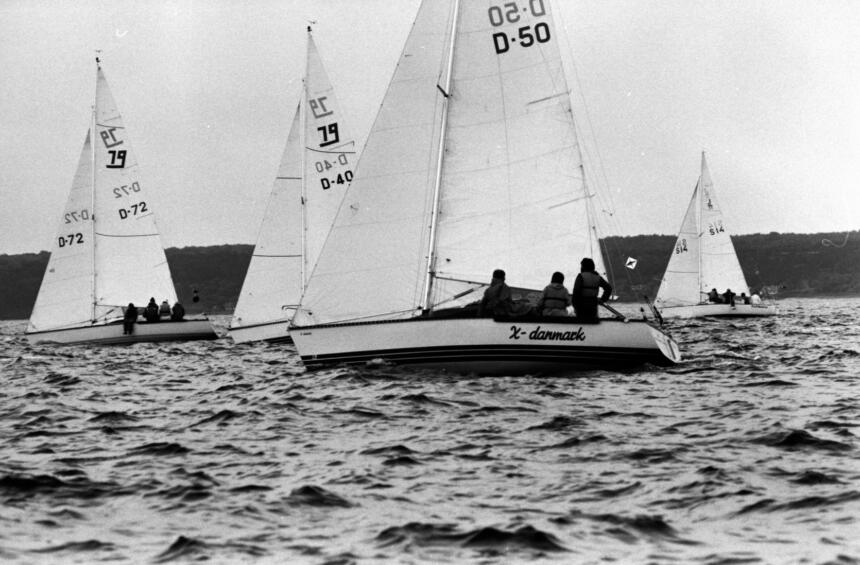
The New Millenium
In 2003, X-Yachts ushered in a revolutionary yachts, further refining its designs and technologies. Entering the 21st century, X-Yachts continued to modernize designs with enhanced performance and luxury. The early 2000s saw the launch of models like the X-332 (432 units produced), X-382, IMX 38, and the popular X-362 (248 units).
During this period, the brand also introduced the Xp (Xperformance) and Xc (Xcruising) series, which redefined the balance between speed and comfort. Models like the Xp 44, Xp 38, and Xc 50 demonstrated the company’s dedication to cutting-edge design and technology.
The introduction of high-end yachts like the X-65 and Xp 55 solidified X-Yachts’ status among premium yacht builders. These cater to both long-distance cruisers and luxury seekers.
Today, X-Yachts remains a leading name in the sailing industry, building on its legacy of excellence. With a diverse range of models and a commitment to pushing the boundaries of design and technology, X-Yachts continues to shape the future of sailing.
The Modern Era
With the launch of the New Generation models in 2014, X-Yachts once again pushed the boundaries of yacht design. This period saw the debut of models like the X-43, X-46, and X-40, which combined modern aesthetics with advanced sailing capabilities.
In 2021 X-Yachts launched their first powerboat – the X-Power 33C and plans to expand the range with 2 model models.
As of 2024, X-Yachts continues to refine and expand its range, focusing on both luxury and performance. Notable recent models include the X49, X56, and the ultra-modern and dual-purpose XR 41.
A Lasting Legacy
X-Yachts has built over 5,700 yachts, establishing itself as a global leader in high-performance sailing. From the X-79 to the latest Xp, Xc, and Pure X models, including the latest XR 41, the company has consistently set industry standards. Have a look at our walk-through XR 41 video we took at boot 2025:
The brand caters to racers, cruisers, and sailing enthusiasts, offering a diverse range of high-performance sailing yachts.
As we look to the future, one thing is certain: X-Yachts will continue to push the limits of what’s possible. By blending craftsmanship, technology, and passion they will keep creating some of the finest yachts in the world.
Adriatic Sea Fishing – Guide for Fishing in Croatia
Planning a trip to Croatia? Whether you’re an avid angler or curious to see if fishing is your new passion, the Croatian coast offers countless opportunities to test your skills and explore diverse waters. The rich Adriatic Sea provides excellent fishing spots. Its many depths, crevices, and rocky areas along the coast make the Adriatic a popular spawning ground for various marine species – the perfect place for successful fishing in Croatia.
First things first: Get your fishing license! In Croatia, only children under 14 are allowed to fish without a license. The application process is simple: fill out a form, pay online, and you’re good to go. There are two types of licenses available: sport fishing and recreational fishing. Licenses can be issued for 1, 3, or 7 days. For sport fishing, you need a valid annual membership card from the Croatian Sport Fishing Federation or an equivalent organization from your home country. If you don’t have your own fishing gear, our charter team is happy to assist and can arrange the perfect set for you to have ready on board your chosen boat.
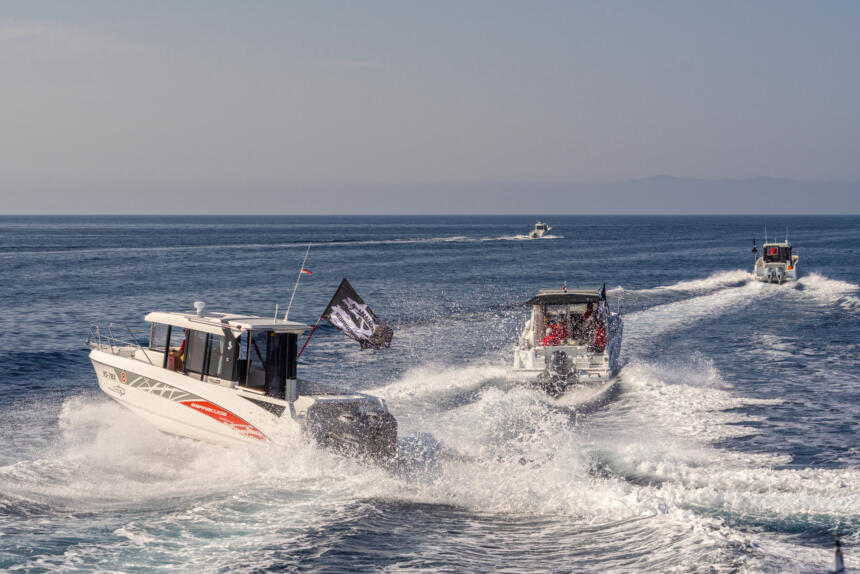
Why fishing in the adriatic sea?
With 1244 islands, islets and reefs, Croatia is often called ‘the country of a thousand islands’. The Adriatic is rich in fish and other marine species. It comes as no surprise that recreational fishing is a practiced sport in the area. It’s a popular industry in Croatia, but also a great way to wind down and relax. What better opportunity to experience this than while exploring the Adriatic aboard your Nava boat? However, keep in mind, the summer crowds and tourists tend to scare the fish and you might have more luck and bigger specimens to catch in late spring or early fall.
Try your luck!
Undoubtedly, expertise, good equipment and luck all play a part, but certainly the location is also an essential element. While many fishermen prefer to keep their best fishing spots, a secret, we’re here to help you get the most out of your adventure. Fishing in the Adriatic offers a wide array of species that are delicious!
It’s important to remember that the most significant skill for fishing is patience! Practice makes perfect, and with some luck you’ll be able to catch two-banded sea bream, sea bass, dentex and even gilt-head bream.
What fish you can expect to catch
- Gilthead (orada/komarca) – probably the best habitat
- Brown meagre (kavala)
- White sea bream (sarag)
- Dentex (zubatac) – specimens smaller than 30 cm should be released back into the sea
- Sheepshead bream (pic)
- Red scorpionfish (skarpina)
- European conger (ugor) – if you catch one smaller than 40 cm you need to release it
- Lobsters and crabs
- Squid (lignja) and garfish (iglica) in the winter periods
- Amberjack (gof)
- European hake (oslic or mol)
- mullet (cipal)
- saddled seabream (usata)
- Two-banded bream (fratar)
- Brown wrasse (vrana)
- Grouper (kirnja)
- Common seabream (pagar)
How to Catch the Fish
When you are trying to catch your lunch or dinner, you’re likely to come across one of the 400 Adriatic sea fish species native in Croaita. Some of these fish include sea bass, sea bream, pandora, mackerel, sardines, sprats, red mullet, and monkfish among others. If you’re lucky, you may even find Mahi Mahi or swordfish at the end of your line!
Big game fishing is very popular in Croatia, and the North Adriatic as well. However, a boat for big game should be equipped for this type of fishing. So, if this is your goal we recommend booking a big game adventure with local connoisseurs that have all the necessary equipment, licenses, knowledge, and experience.
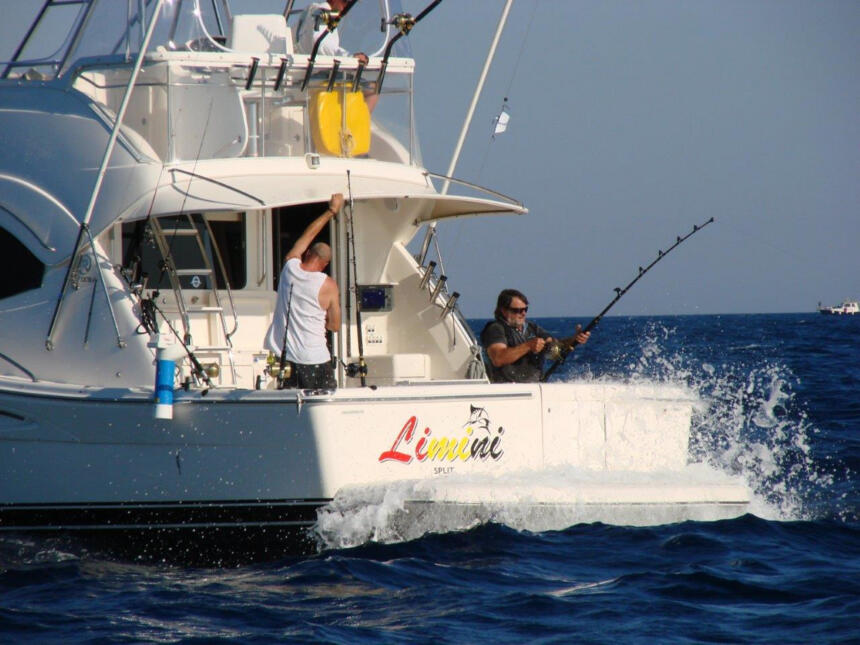
Bottom Fishing
Sea Bass (Lubin or Brancin, in Croatian) is one of the most appetizing fish found in the Adriatic. Skip the restaurants and catch this fish in shallow waters close to the shore. Check if you can taste the difference when catching it and cooking it yourself! Moreover, on a crewed charter, your experienced chef is likely to make it into a memorable meal. The best way to attract delicious sea bass is bottom fishing or jigging – give it a try! Using this technique, you’re also likely to attract some other fish such as cuttlefish, sea bream, dentex and mackerel.
Spearfishing
Looking for some adrenaline? You could also try spearfishing for a delicious labor-intensive catch. Dinner will taste even better after a long day at sea. According to Croatia’s Maritime and Fishing rules, you can spearfish only during daylight, for obvious reasons. No oxygen bottles are allowed and you can only have 2 spearguns. You require a sport fishing license (this means you need to be a member of a sports fishing federation). Despite its thrilling nature, this activity requires excellent physical and mental capability because of the diving and weapon use. The best time for this activity is in the late summer and early fall when you ought to find the most rewarding catch on the rocky seabed.
The Best Fishing Spots in Croatia
Undoubtedly, fishing in Croatia combines perfectly with a crewed charter vacation. Certainly, the main advantage is that you have your professional “guide/skipper/fisherman” right with you onboard. This means hitting the best spots. Here’s a selection of of crewed boats:
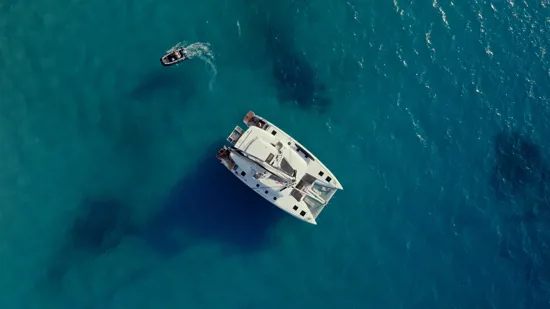
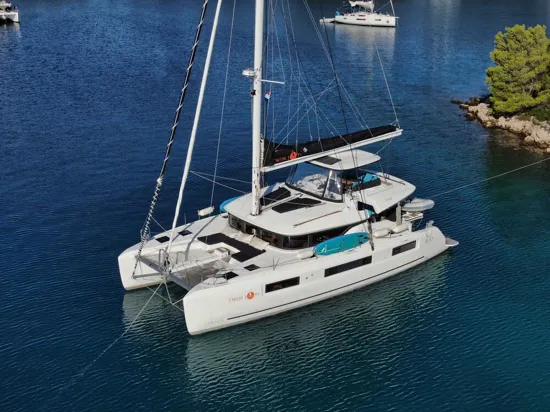
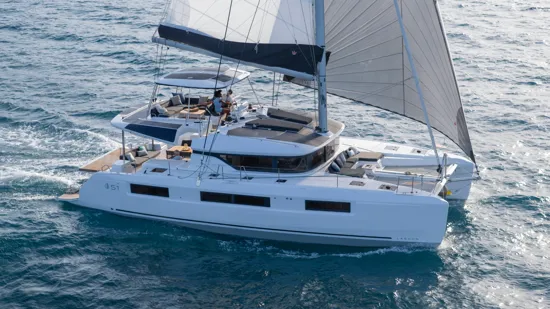
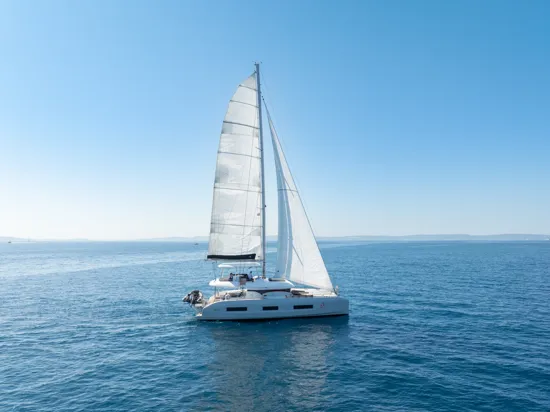
-dth.jpg.webp)
However, if you’re chartering your vessel bare boat, we’ve compiled some of the best spots for recreational fishing.
Vis Island Fishing
Vis Island is a top destination for deep-sea fishing, especially for those seeking bluefin tuna and swordfish. Located far from the mainland, Vis has some of the richest fishing grounds in the Adriatic, making it ideal for both shore and boat fishing. The island’s underwater topography, with its deep trenches and nutrient-rich waters, attracts a variety of large fish. The best fishing spots on Vis: Komiza Bay, and Bisevo Island.
Pakleni Islands
Just off the coast of Hvar, the Pakleni Islands are an excellent location for catching sea bream, amberjack, squid, and octopus. The islands are known for their vibrant marine life, with deep channels and rocky seabeds. Don’t miss the best fishing spots such as Palmizana, on Sveti Klement island, and Vodnjak Reef
Brac Island
Brac is a diverse fishing destination, offering both deep-sea and shore fishing opportunities. The area around Zlatni Rat Beach and other interesting sites are home to sea bass, dentex, and groupers.
Zadar Archipelago (Dugi Otok, Ugljan, and Pasman)
The Zadar Archipelago offers a mix of deep-sea and inshore fishing, with Dugi Otok being famous for tuna and grouper, while Ugljan and Pasman provide fantastic shore fishing experiences (sea bass and mullet).
Peljesac Peninsula
Pelješac Peninsula is a fantastic spot for catching squid, octopus, dentex, and sea bass. What’s more dingac, excellent red wine, grows on the peninsula so you must try it when dining fish.
Moreover, Mali Ston Bay is famous for its oysters and mussels, so we highly recommend to enjoy the full seafood experience.
Mljet Island
Mljet is one of Croatia’s most untouched islands, making it a great spot for anglers. The clear waters are perfect for seabream, cuttlefish, and sea bass. Parts of the island are within a national park, so fishing is allowed only in limited areas and with a special permit from the National Park.
Rovinj – Pula
This area in Istria is a prime spot for mackerel, mullet, sea bream, and John Dory. The town is known for its fishing heritage, and both sport and spearfishing are popular activities. Sea currents around Lim Bay create nutrient-rich waters, making it a hotspot for fish.
Sibenik Archipelago (Kornati and Zirje Islands)
The waters around the Sibenik Archipelago, especially near Kornati National Park and Žirje Island, are teeming with tuna, swordfish, and dentex. These islands provide excellent big-game fishing opportunities.
The fishing industry around Kornati is big. The rich waters and marine biodiversity is a great advantage for fish and fishing enthusiasts alike. It is important to mention that fishing within the Kornati National Park is allowed by law, but strictly a no-fishing zone according to the regulations of the national park. So, in order to avoid a fine, we recommend doing it outside the park limits. Expect to catch here common dentex, grouper, red scorpionfish, white sea bream, common pandora, sea bass, gilthead and many other species.
Lastovo Island
Remote and still not too crowded with tourists, Lastovo Island offers some of the best fishing grounds in Croatia. Dentex, amberjack, and snapper thrive in the deep surrounding waters.
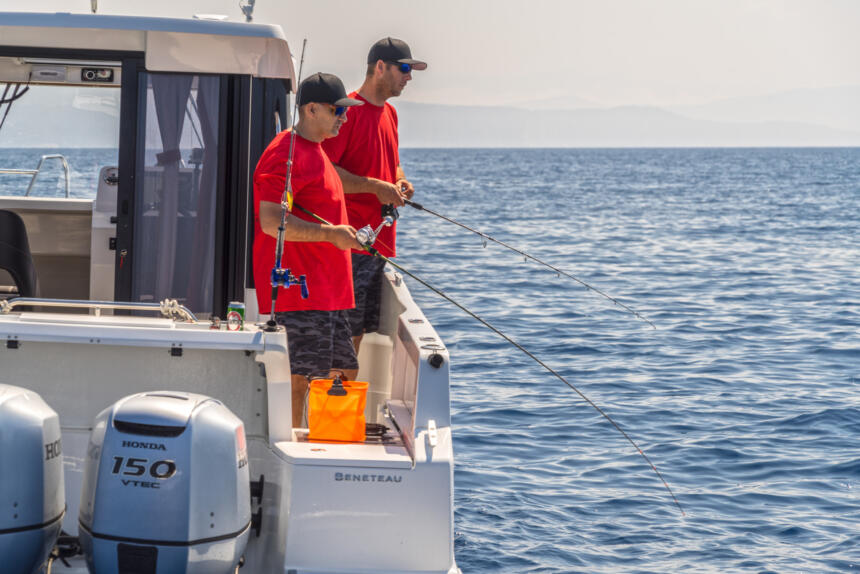
Be Sustainable!
Fishing methods are usually passed down from generation to generation. In case you charter our boat with our local skipper, know that they are well-versed in the best tips for fishing and some have their own equipment (if not, you can rent fishing gear with Nava, just reach out to our booking team before your charter start). Most skippers are happy to assist and guide you through your fishing adventures!
When partaking in recreational fishing, please remember that, unfortunately, we humans often bring disbalance and sometimes threaten marine wildlife. Thus, in recent years, more native species have become endangered. Keep in mind to release specimens that have not reached the required length or weight. In any case, only catch what you mean to eat. And bear in mind that the daily limit is 5 kilograms.
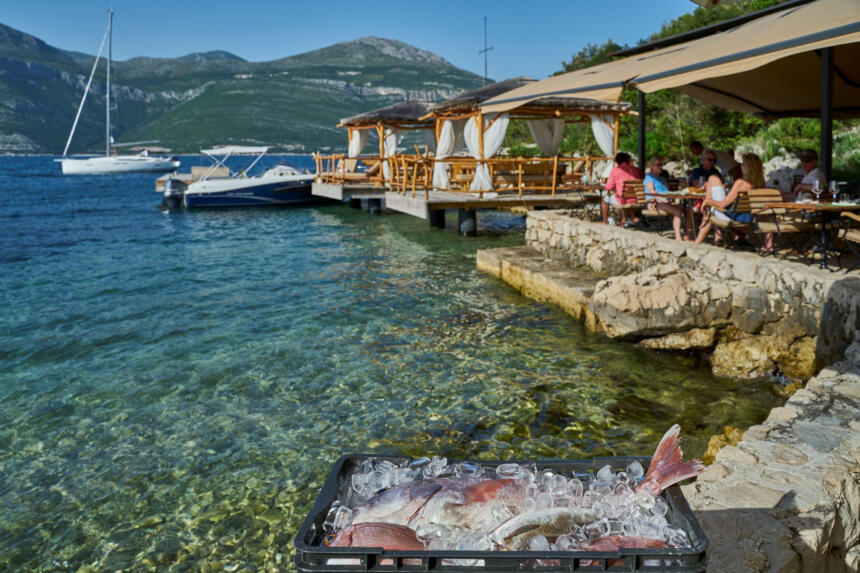
Protected sea species
The following species are protected in the Adriatic waters: ocean sunfish, fan mussel, date mussel, Caspian gull, green wrasse, Holothuroidea, Mediterranean monk seal, common bottlenose dolphin, common dolphin, all whales, all sea turtles, some shellfish, Triton’s Trumpet and Neptune Grass. Find the full list of species on the Croatian Tourist Board website.
The charms of this sport are certainly its unpredictable nature and the mixture of luck and skill necessary for a successful fishing adventure. If you would like to give it a try during your charter, contact our charter team at charter@navaboats.com or call Nautika Centar Nava at +385 021 407 700. We’ll be happy to help you select the perfect boat for you and prepare a fishing set on board your chosen boat.
Navigating the Adriatic Winds: Tips for Sailors & Travelers
Croatia is a perfect summer sailing destination, thanks to its predictable and favorable wind patterns. In ideal weather conditions, the Adriatic winds are characterized by calm nights, making them perfect for anchoring and restful sleep. The early mornings offer smooth seas, allowing motorboats and those who prefer a gentle cruise—without strong waves or wind—to reach their next destination comfortably.
Unlike the Aegean Sea or the Ionian Sea in Greece, where strong winds can blow relentlessly day and night, Croatia’s Adriatic coast offers a unique balance—ideal for both relaxed cruising and thrilling sailing. This makes it one of the best sailing destinations, not just for its stunning coastline and islands, but also for its exceptional meteorological conditions.
Are you ready to learn more about the Adriatic winds, the weather, climate, sea temperature, and sea currents?
Where is the Adriatic?
Let’s start at the top – location! The Adriatic Sea is an arm of the Mediterranean Sea in Southern Europe. It separates Croatia and other countries of the Balkan Peninsula from Italy. Geographically, the Adriatic Sea is divided into South and North at cape Planka (near Rogoznica). The winds, weather, and the climates slightly differ in these two main regions. But, they also have a lot in common.
There are over 1300 islands and islets in the Adriatic Sea, and most of them, 1244 to be specific, are in Croatia. The northern part of the Adriatic Sea has the shallowest water.
Croatian counties in the North Adriatic include:
- Istria
- Primorje-Gorski Kotar (Kvarner)
- Lika-Senj (Lika-Senj)
- Zadar
- partial Šibenik-Knin
And in the South Adriatic we have:
- partial Šibenik-Knin
- Split-Dalmatia
- Dubrovnik-Neretva

Weather conditions in Croatia
Climate and weather conditions
The Köppen climate classification designates the climate in the North Adriatic Sea as humid and subtropical, with wet summers and cold and dry winters. The South Adriatic is classified as hot-summer Mediterranean climate. During the summer, the average air temperatures are between 27 – 30 °C (80 – 86 °F). Winters are quite cold because of the cold bura winds blowing from the land.
You can check the current marine weather forecast in Croatia at the official DHMZ site.
Sea temperature
Summers in the Adriatic Sea are warm! The sea temperature is typically from 22 to 30 °C (72 to 86 °F). This makes swimming or simply enjoying time in the water very pleasant. However, the temperature in the winter usually drops to 12 °C (54°F). Find more information about the weather during the summer season in our previous blog.
Sea currents
In general, sea currents in the Adriatic are not that strong and significant. They are much stronger along the west (Italian) coast.
In the winter the currents are mostly incoming along the Eastern Adriatic Sea, and in the summer outgoing along the Western coast. The dominant Adriatic currents flow counter-clockwise. They start from the Italian city Otranto, follow the Croatian coast to the north, and lastly back towards the Italian coast. The speed of the currents in the Adriatic Sea has an average of around 0.5 knots (0.9 km/h). Besides, their speed changes in specific areas and times.
Thunderstorms
Even though Croatia is famous for very sunny weather, with for instance around 2700 sunny hours in Hvar, thunderstorms are still possible even during the long hot summer. However, bad weather conditions such as are more common in the North Adriatic. They usually quickly pass, you just need to find a safe harbor to weather it out.
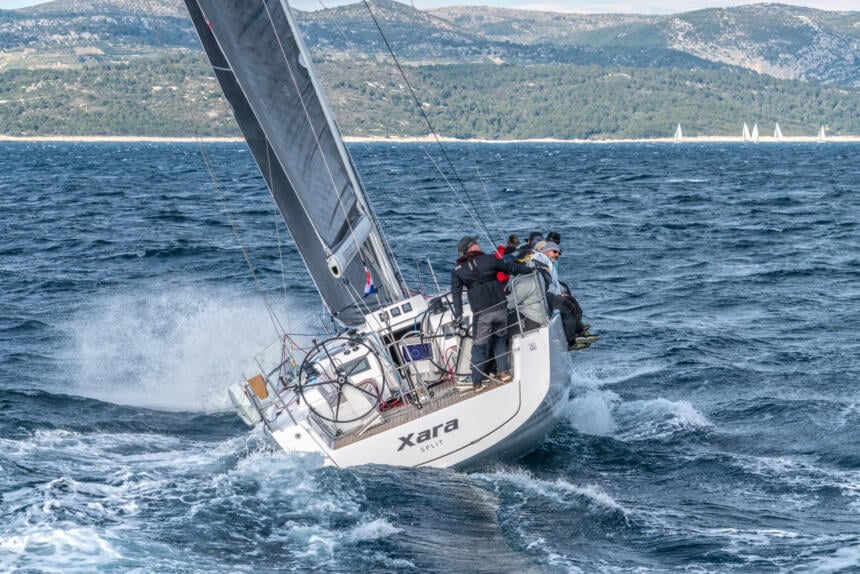
Adriatic Winds
Winds are one of the most significant components of the weather on the Adriatic. The most important winds on the Adriatic are Bura and Jugo. Luckily, during the summer, they are usually less potent. But the true helper in your sails – is the Mistral. It’s very trustworthy and just strong enough to get you almost anywhere.
If you’re interested in the current situation of the winds in Croatia (North Adriatic) head on over to windy.com.

Bura
Certainly, one of the infamous winds in Croatia, and particularily in the North Adriatic is the queen – Bura. It is typically associated with cold weather. Bura is a cold and very strong northeast wind blowing from the mountains. In some cases, bura might cause serious trouble to navigation due to its sudden appearance and gusts that make it very unpleasant and unpredictable. Nevertheless, bura often means fresh air with plenty of sunshine.
Throughout winter, bura might last from 12 hours to 2 days. During these times, bura’s speed can accelerate even up to 60 knots (111 km/h). However, on average, it remains around 35 knots (64 km/h) in the winter. As a matter of fact, the strongest winds in Croatia blow in the area underneath the Velebit mountain. Because of the specific position, the winds in this area can blow in multiple directions. And the highest velocity ever officially measured in Croatia was in December 1998 at the Maslenica bridge – 248 km/h (154 mph).
Despite the higher possibility of extreme bura weather, sailing off-season has many advantages. If you wish to know which, read our blog on why sailing off-season is so great. But, be aware of possible threats and check weather conditions more often than you would in the summer. Above all, head to any warnings either by the meteorological services or our base manager.
Jugo
Sailors associate this wind with bad weather. Jugo is an east-southeast warm and humid wind that blows from the islands towards the seaside. It’s sometimes called scirocco. Even though the wind is warm, it typically brings cloudy or rainy weather.
Moreover, jugo unlike Bura is a constant wind that gradually gains strength over time (a day or two). Here are a few signs that announce the jugo:
- a calm sea
- weak winds from changing directions
- an unclear horizon
- a rise in temperature and humidity
- a gradual air pressure drop
- the waves from the southeast become bigger and bigger
Once it starts, it causes high and choppy waves.
People in Croatia usually blame jugo for everything negative that happens to them. Anything from low productivity levels to broken legs or bad grades in school or burnt lunch. If you aren’t having a good day, just blame it on the jugo “To ti je jugo!”. And maybe you will feel better, or at least when it blows over! Jugo appears more often and stronger in the south. Jugo has only the fifth wind velocity score ever measured in Croatia. It was recorded in Palagruza and the speed was almost 205 km/h (127 mph). The first score (as mentioned above) and the following three are held by the infamous Bura. The Jugo blows more frequently in the winter and spring in the North Adriatic, whereas in the summer it mostly appears as a local wind and stays in the south.
Maestral
One of the defining winds of the Adriatic is the Maestral, a reliable thermal breeze that typically starts around noon, reaches its peak strength around 5 PM, and gradually subsides in the evening. This wind is a dream for sailors, providing steady conditions for an exhilarating sailing experience. As the Maestral dies down, the Adriatic once again settles into a peaceful state, ensuring a tranquil night at anchor.
Sailors know it as a “friendly wind” that comes from the sea to the land. Moreover, mistral blows during the anticyclone. It’s been known under this name since the 15th century.
For the most part, it feels like a gentle summer breeze. Therefore, mistral will not negatively affect your holiday. It will only refresh you during the hot summer days. Also, it is typically stronger in the South Adriatic.
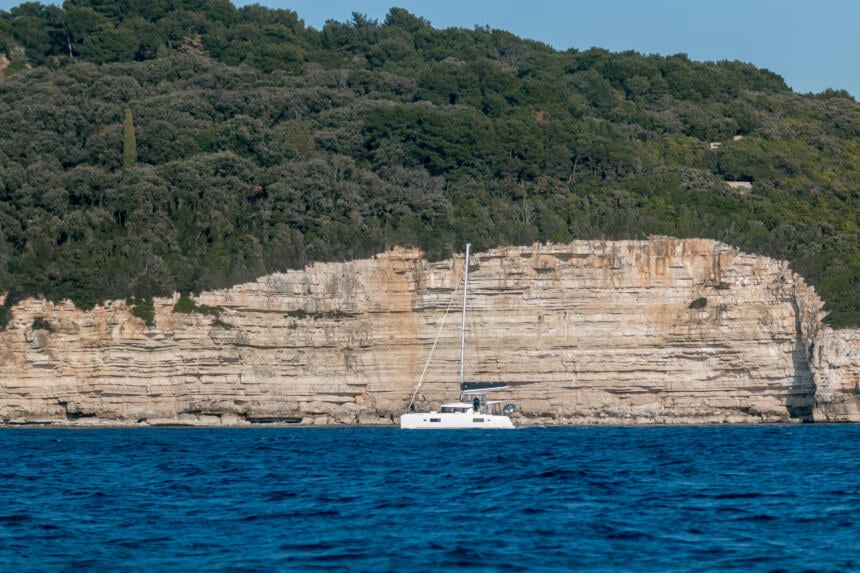
Tramontana
The name tramontana comes from the Latin virtues transmontanus, which means wind blowing through the mountains. It is a common name for the northern winds in many parts of the Mediterranean. It is a cold, medium-intensity wind that blows most often in good weather. Its appearance is a sign of improving weather.
Levant (levanat)
The levant, as the name describes, is the wind coming from the east. It is usually a moderate, rarely strong wind that blows when the weather is cloudy, wet, and rainy.
Ostro
Ostro or lostrac is a southerly wind. It is a hot and humid wind that typically does not blow very long, but can develop a significant force. A low-intensity ostro is called lostrine, a high-intensity lostracine.
Burin
Burin is a gentle summer wind or breeze, kind of welcoming on a hot summer day. Blowing from the north at night, it announces a clear sky.
Lebic
The southwest winds in Croatia, in the Adriatic, have one of two names: lebic or garbin. The lebic is most commonly a dry and warm wind, which blows after the jugo when the Mediterranean cyclones pass over the land to the west and the center of our country. It usually does not last very long, but it can blow very hard (lebicada).

Get on board with us!
Now that you know more about the Adriatic winds in Croatia, you are ready for the perfect sailing holiday. Besides the good weather here, there are many beautiful spots to see. Some of the best ones are only (or best) reachable by boat. Select one of our top catamarans, sailboats, or motorboats from our new charter bases in Split and Rogoznica.
Simply contact our charter team and enjoy sailing with us. Our charter team will get back to you as soon as possible. Your dream vacation is only one click away!
Book Your Perfect Charter Vacation – Lagoon 51 – Reality from Split, Croatia
Reality is one of three splendid Lagoon 51. It’s also the latest addition to our charter fleet and the only available for charter from our headquarters and base in Split. The model itself is an ideal combination of elegance and functionality.
Book this state-of-the-art catamaran with her professional and skillful skipper and enjoy luxury and practicality on board. It’s a perfect choice for large families, as it accommodates up to 10 guests.
Sophisticated Accommodation for All
Reality has four spacious double cabins with island beds, each featuring an en-suite bathroom for ultimate comfort and privacy. Plenty of storage space in the cabins and throughout the yacht lets you store all your belongings during your cruise. Additionally, the yacht includes two smaller middle cabins that can accommodate either one adult or two children in each. However, these cabins don’t have a bathroom.


If you choose to enhance your experience with an optional hostess and/or chef, one or both of these inner cabins is designated for them. A dedicated skipper cabin and head are conveniently located in the bow.
Seamless Indoor-Outdoor Living


The Lagoon 51 is crafted to elevate your sailing experience with its innovative design that blends indoor and outdoor spaces. The bright saloon is perfect for socializing or relaxing.
Adjust the modular seating on the inviting flybridge and enjoy breathtaking views. The forward cockpit is another intimate setting for enjoying panoramic vistas with some snacks or cocktails. At last, there’s the spacious aft cockpit that’s ideal for dining al fresco or unwinding after a day of exploring.
For those seeking adventure or relaxation by the water, the Lagoon 51’s large transoms ensure safe and easy access to the dock , the sea or a plethora of water toys.
Exceptional Comfort and Amenities
Every detail of the Lagoon 51, Reality, is designed with your comfort in mind. The yacht is fully equipped with:
- A generator, inverter, air conditioning, and heating for year-round comfort.
- A watermaker, ice maker, and a fully equipped galley, including a freezer, coffee maker, dishwasher, microwave, and stove with oven, so preparing any culinary delight is a breeze..
- A TV with DVD and a premium Fusion Apollo audio system with speakers in the saloon, cockpit, forward cockpit and on the fly for dictating crew vibes and atmosphere.
- Wi-Fi to keep you connected throughout your journey.
The flybridge and cockpit are shaded with sun covers, and soft cushions provide ultimate comfort under way or at anchor. A cockpit shower lets you quickly refresh after a swim, while the tender, equipped with a 20 HP outboard engine, makes explore hidden coves and beaches.
Water Toys for Everyone
There are many ways to stay active and entertained while on the water. The complimentary snorkeling gear and two SUP boards allow you to fully experience the underwater world and the surrounding seascape.
In the crystal-clear waters a diverse marine ecosystem awaits. You’ll have the opportunity to see fish darting through the water, discover sea urchins nestled amongst the rocks, and perhaps even encounter the elusive octopus camouflaged against the seabed. The occasional coral formations, swaying posidonia meadows, and diverse sponge species create a mesmerizing underwater landscape that’s fun to explore. Each cove offers a unique snorkeling experience, so take your time and discover the hidden treasures at your own pace.
For those who crave a bit of friendly competition, organize a SUP race and see who paddles best. The winner can proudly claim the title of “king” or “queen” of the cruise.
Perfect for Families and Groups
The Lagoon 51 is an exceptional choice for a large family or two smaller families looking to share a private cruise. With the guidance of our skipper, you can explore the stunning Croatian coastline. You’re welcome to take part in the sailing experience and learn some basic sailing terms, maneuvers, or principles. Or you could simply unwind and soak in the beauty around you.
Safe Sailing with a professional skipper
Our skillful and highly-trained skipper is ready to make your Croatian coastal adventures unforgettable. With friendly attitude and focus on safe and enjoyable experiences the skipper’s extensive knowledge of the Croatian coastline ensures a smooth cruise and an opportunity to discover hidden gems and tranquil bays without the excess crowds or in the midst of them (whichever way you prefer it). With a qualified skipper at the helm, you can relax knowing you’re in capable and caring hands.
On board, the skipper uses the skipper cabin and bathroom facilities in the bow, which allows even more privacy.
Optional Upgrade to Your Charter
Further elevate your Reality charter experience by opting for the additional services of a professional hostess or chef. This optional upgrade maximizes your comfort and convenience and allows you to fully enjoy a luxurious sailing vacation. With a dedicated hostess or chef on board, you can enjoy personalized service, delectable meals tailored to your preferences, and a spotless living space throughout your journey. The additional crew member(s) utilize(s) one or two of the smaller inner cabins and the crew bathroom facilities in the bow. A seamless service and privacy are guaranteed. Learn more about the duties of each crew member in our previous blog – crewed charter guide. Whether you desire gourmet cuisine, attentive service, or simply wish to relax and savor every moment of your charter, hiring a hostess or chef is the perfect way to upgrade your Lagoon 51 experience.
Book Your Sailcation on Board the Lagoon 51 – Reality
Embark on a journey of discovery and relaxation aboard the Lagoon 51, Reality, with Nava charter. Experience the perfect blend of luxury, comfort, and adventure as you sail along the Adriatic’s blue waters. Charter this Lagoon 51 and let the Croatian coast become the backdrop for memories you’ll treasure forever.
Luxury, Adventure, and Relaxation in Croatia – One Day Aboard a Crewed Yacht
Have you ever wondered what a typical day aboard a crewed yacht in Croatia is like? Imagine waking up to the gentle sway of the ocean, enjoying delicious meals prepared by a chef, and exploring breathtaking destinations with a dedicated crew taking care of your every need.
While embarkment and disembarkment days slightly differ, other days on board share many similarities. On the day of your arrival, expect a safety briefing and agreement on yacht rules and roles, defining destinations and route possibilities in accordance with the weather conditions. Then it’s on to settling in, learning how to use any appliance or amenity on board. And finally, getting used to your floating “villa”.
Here is the first selection of crewed yachts. Check out the available boats:




-dth.jpg.webp)
Morning Bliss
Your day begins with the soft glow of the morning sun streaming through your cabin windows. Or, you could welcome the sun by some morning meditation or yoga practice on the flybridge, bow or the platform. The sound of waves lapping against the hull sets the perfect tone for a peaceful start. Enjoy the fresh sea breeze and panoramic views from the deck.
Breakfast is served al fresco on the preferred dining area: aft cockpit, saloon, or the flybridge. Depending on yacht size and the crew combination you selected, a hostess or a chef prepared a menu tailored to your preferences. Various sorts of eggs, charcuterie, pastries, fresh fruit, and a selection of juices, teas, and coffee. It’s the perfect moment to plan the day’s adventures with your crew.

Mid-Morning Exploration
After breakfast, take a quick swim or set sail immediately for your first destination of the day. When cruising the historic coastline of the Adriatic, every moment is memorable. Be on the lookout for dolphins, relax on the sun deck, enjoy a book, or assist the captain and learn some sailing tips.
Upon arriving at a secluded cove or vibrant harbor, the adventure begins. Dive into crystal-clear waters and explore the fascinating underwater world with the snorkel sets, paddle or kayak around the yacht. The crew is always on hand to guide you, ensuring you make the most of the activities and discover hidden gems along the way.
A Delicious Lunch
Back on board, a light lunch awaits if you have a hostess on board. In case you booked a yacht with a chef, the meals include more courses. But their menus are always inspired by local flavors and ingredients, and range from freshly caught seafood, crisp salads, and handmade desserts. Enjoy your meal while anchored in a serene bay, with nothing but the sounds of nature around you or some light ambiance music from the yacht’s impressive sound system.

Afternoon Adventures
The afternoon is yours to explore further. Perhaps you’ll take a short hike onshore to discover scenic views or visit a charming coastal town. If relaxation is your goal, lounge on the deck with a refreshing drink.
For thrill-seekers, the yacht’s collection of water toys is at your disposal. Try water skiing, tubing, or wakeboarding. Every moment is tailored to your interests.
Sunset Serenity
As the day winds down, the yacht sets sail for a picturesque spot to watch the sunset and spend a tranquil night. Watch the sunset on board over some cocktails or a glass of fine local wine or liquor and then dine in a local restaurant recommended and booked by the crew in case you opted for a hostess. If you have a chef on board let him/her treat your taste buds with yet another meal according to your preference. And watch as the sky transforms into a masterpiece of colors. It’s a perfect time to reflect on the day’s adventures and take photos to remember the moment. This is also a great time to plan activities and destinations to follow.

Evening Elegance
After dinner, the evening is yours to relax. Enjoy a night out if you are docked in a vibrant town, a late night swim if you are anchored in a quiet bay. Or watch a movie in the saloon, stargaze from the deck, or grab a nightcap with your loved ones. Once you are ready to conclude the day – retreat to your private and comfortable cabin with en-suite bathroom, unwind and prepare for new adventures.
Why Book a Nava Crewed Yacht in Croatia?
At Nautika Centar Nava, we specialize in creating unforgettable yacht charter experiences. From personalized service, pre-defined and custom-made programs, to luxurious amenities, we design every aspect of your vacation to exceed expectations. Contact us today to plan your dream escape, and let us make your vision of a perfect day on the water a reality.
Nava has been in the charter industry since 1990. Moreover, we are one of the leading Lagoon catamaran representatives since 2001. Our local in-depth knowledge and trustworthy associates guarantee a crewed yacht charter experience of a lifetime.
Cooking on a Boat – Boat Food Ideas
Staying outdoors and at sea always makes everyone hungry! Sailing the Adriatic gives you a bigger appetite than mainland. And so much for the better! Croatia is full of dishes and flavors that you must try. For that, many restaurants are here to help you. However, your sailing cruise is bound to include some cooking on a boat, too.
Cooking on Nava Boats
For some, cooking on a boat may sound scary, but it doesn’t have to be! Most of our boats are equipped with a galley with a stove, an oven, a refrigerator, and even a freezer. On board most of our catamarans, you practically won’t even notice the difference from your everyday kitchen. Catamarans over 45 feet in length also have a coffee machine with 32 coffee capsules included in the obligatory comfort package. If you need more, just let us know and we’ll prepare an extra caffeine boost for you and your crew.

Even the galleys on board sailboats and motorboats are excellently equipped, with enough storage space. Furthermore, almost every small village on the Croatian coast has a shop or smaller supermarket. All that you need are boat food ideas, a provision list, and some recommendations for restaurants! Don’t worry, we’ve got you covered: we’ve created a menu with suggestions for the best boat food ideas, extra recipes, and restaurant recommendations. No more excuses for not cooking on board!
Breakfast ideas on a boat
Let’s start with the most important meal of the day (for some). Since everybody has their own preference, your breakfast “bar” should be well-equipped. Some like it sweet, some like it salty or sour, and some just like COFFEE!

For a fulfilling breakfast every day you should always have some hot beverages such as tea, coffee (moka pots are on every boat), milk, and maybe hot chocolate. Also some juice, for instance; orange, grapefruit, apple. Add some fresh bread of your choosing with jam, butter, chocolate spread, cream cheese, honey, or paté, plus cereals, muesli, French toast, pastries, yogurt, fruits, eggs, ham, bacon, sausages, and cheese, and you have all bases covered.
If you want to diversify your breakfast, make some crêpes, pancakes, or buy some waffles or cookies.
If you go out the night before, and you decide to get up late, why not have brunch? It’s basically what we proposed above, plus some bruschettas with avocado, salmon, and cream cheese and some salads with tomatoes, mozzarella, burrata, tuna, and cucumber. It’s up to you!
Snacks and drinks on board
It’s always a good idea to have snacks, especially with children on board. Buy cookies, biscuits, cakes, yogurts, chocolates, and fruits, or make pancakes, crêpes, and sandwiches for a snack. Melons and watermelons are a delight in Croatia, and so refreshing!
Don’t forget the typical Croatian cheeses, cold cuts like prosciutto, salami, some olives, and crackers. Of course, to accompany the food, you definitely have to try some wines!
White wine : grasevina, malvazija, posip, grk, vugava
Red wine : plavac mali, babic, lasina, dingac
Try reducing sodas (such as Coca-cola, Pepsi, and if you prefer, Sprite, Orangina, and Fanta – give Pipi a go – this is a local soda) to a minimum because they contain a lot of sugar and may misguide your thirst.
Try some local beers. For instance, karlovacko, ozujsko, pan, or better yet from some local brewery. Although, canned drinks are more practical on a boat, since they do not break if they fall, keep in mind only glass bottles are 100% recyclable.
And for those celebratory moments or special occasions on board, don’t forget to stock up on some prosecco! Its effervescence and lightness make it a favorite among many.
Water
Of course, the most important supply on a boat is water! Don’t forget to bring water! At sea, we are constantly exposed to the sun and wind, not to mention the salty sea air. It is therefore essential to stay hydrated, even more than usual. Always have approximately 2 liters of water per person, per day. The water in the water tanks is OK for cooking but not for drinking, so we recommend buying bottled water 2 or 3 times during your cruise.
Remember to check the water tanks and refill them according to need. We recommend buying big 5 L water canisters to reduce plastic waste. It would be good if every crew member had his/her own glass or thermos bottle to refill several times during the day.
Now, it’s time for the meal planning and the 7-day menu on board while cooking a boat.
DAY 1: Saturday
Usually, when you charter a boat at Nava Boats, with all the papers, check-in, and procedures, you board the boat later in the afternoon, at 5 p.m., at the latest. Therefore, for lunch, it’s best to eat at one of the restaurants around our marinas. For instance, our main base, in Split, is only a 10-minute walk from the city center where there are many great restaurants.
DINNER On the first evening, after the tiring day you just spent, we strongly advise you to set sail for the nicest cove or marina and dine in a restaurant. Depending on your starting point (Split or Rogoznica). Here are a few suggestions:
| North Dalmatia | Central Dalmatia | South Dalmatia |
| Primosten: Tavern Dvor or Restaurant Mediteran | Hvar, Hvar Island seafood and fish: restaurant Gariful | Kobas (near Ston City): restaurant Gastro Mare Broce |
| Skradin, Toni tavern | Maslinica, island Solta Martinis Marchi restaurant | Sipan island: Kod Marka tavern |
| Maslinica, island Solta: Martinis Marchi restaurant | Pučišća, Brac island Pipo | Mljet, Ankora Tavern, Polače |
| Zlarin, Prslika tavern | Jorja Bay, Solta Island tavern Kike | Dubrovnik city, Lucin kantun |
DAY 2: Sunday
LUNCH : for the first lunch of cooking on a boat, try something that is not too hard to do, so that you get used to the galley. And everybody knows an easy meal, equals pasta! We propose garlic & shrimp spaghetti.
You need:
- spaghetti
- shrimps
- garlic
- Spices (hot paprika or Cayenne pepper, salt, pepper)
- fresh parsley
- olive oil
Recipe:
Peel and mince your garlic. Cook the pasta according to instructions. Meanwhile, sauté the shrimp in a drizzle of olive oil for 4 minutes with the minced garlic and spices. Once the pasta is cooked, drain it briefly and mix it in with the shrimp. Continue cooking for 1 more minute, mixing the two together. Serve with a drizzle of olive oil and enjoy!

DINNER: For dinner, we propose a meal that everyone will like: Mashed potatoes with chicken.
Prepare:
- potatoes
- chicken breast
- bacon
- sprig of thyme
- garlic
- olive oil
- salt/pepper
Recipe :
Wash the potatoes. Peel and cut them into slices, then dry them in a clean cloth. Dice the chicken breasts. Boil the potatoes until soft, then mash them with a fork or masher. In a separate pan, fry the chicken breast with bacon, garlic, thyme, salt, and pepper. Serve the mashed potatoes with the chicken and enjoy!
DAY 3: Monday
LUNCH: Since you ate well the day before, we suggest a simple salad to make for lunch: seasonal salad with cherry tomatoes, feta cheese, peppers, and avocado.

Ingredients:
- avocados
- cherry tomatoes
- Feta cheese
- red bell pepper
- red onion
- salad (lettuce, lamb’s lettuce, arugula…)
- olive oil
- salt/pepper
- pine nuts
- croutons
Just mix it all in. For the extra hungry ones (or those in need of extra proteins), add some cevapcici or pljeskavica (Balkan specialties made of hacked meat) that you can get at almost every butcher’s shop and most shops.
DINNER: We recommend making a risotto! For example, risotto with Parmesan.
You need:
- risotto rice
- dry white wine
- onion
- parmesan
- butter
- chicken broth cube
- olive oil
- salt/Pepper
Recipe:
Heat some oil in a pan and sauté the peeled and chopped onion. Add the rice and sauté for 2 to 3 minutes until it is pearly. Pour in the white wine and let it evaporate. Add the simmering broth ladle by ladle, waiting for it to be absorbed before adding more, stirring regularly. Count about 18 minutes of cooking. Add the diced butter, salt and pepper, add the Parmesan cheese. Serve and enjoy!
DAY 4: Tuesday
LUNCH: We know that while sailing, you make a lot of stops and a lot of things. You don’t necessarily have time to do anything complicated. So this lunch, why not enjoy some pizza? It’s simple and quick to make. You can make pizzas any way you want.
Get some:
- pizza dough
- various kinds of cheese
- ham, various cold cuts, capers, olives, peppers, tomatoes
DINNER: This evening, why not rest your cooking skills a bit and go to a restaurant?
| North Dalmatia | Central Dalmatia | South Dalmatia |
| Dugi Otok island, Verunic: restaurant Gorgonia Grill | Supetar, Brac island: Konoba Vinotoka | Korcula, Korcula island: Mediterranean food – Filippi Restaurant |
| Murter, Murter Island: Konoba Boba | Stari Grad, Hvar island: Mediterranean food, Kod Barba Luke | Ston City: Tavern Bakus |
| Sibenik, Pelegrini restaurant | Solta Island, Sesula Bay: Tavern Sesula | Pomena, Mljet Island: Konoba Galija |
| Skradin: Konoba Dalmatino | Vis: restaurant Villa Kaliopa | Lastovo Island, Zaklopatica: Tavern Santor |
DAY 5 of cooking on a boat: Wednesday
LUNCH: You probably realize that you haven’t cooked any fish since the beginning of the trip. But we hope you ate some delicious seafood at the restaurants. And yet they are all around you when you sail! So for this lunch, why not eat a good seabass wrapped with vegetables?
You need:
- seabass filets (available in larger shops or supermarkets)
- carrots
- leeks
- celery
- onions
- olive oil
- salt/pepper
- lemon
- white wine
- thyme
- butter
Recipe :
Preheat your oven to 210°C. Peel and finely chop the leek, carrots, celery, and onion. Place each fillet of sea bass on a piece of parchment paper. Cover the fillets with the vegetable mixture. Add olive oil, white wine, thyme, butter, and 2 lemon slices per sheet. Season with salt and pepper, then seal the sheets. Place them in an ovenproof dish for 20 minutes. If vegetables aren’t enough, feel free to accompany your dish with rice or any other side dish you wish. Serve and enjoy!

DINNER: For the evening, why not change a little and prepare a buffet-dinner? Mix some cold cuts/ham and Croatian cheese together with crackers, and add simple bruschettas, olives, or pistachios. Cut up some vegetables to eat with sauce, such as cherry tomatoes, cucumbers, carrots, celery… Make avocado toast with salmon, tuna mousse, paté… Dip breadsticks in hummus, tzatziki, guacamole, and cottage cheese. Cut small pieces of fruit such as melon, watermelon, apple, strawberries, grapes, figs, cherries (depending on the season). The choices are endless, depending on your desires!
DAY 6 cooking on boat: Thursday
LUNCH : Ok, it’s true that we proposed pasta on your second day on board. But it’s always pasta time! It’s the perfect meal if you want to make something tasty, quickly and easily. Everything goes great with pasta, and it’s always delicious. And for day 6 of cooking on a boat, we suggest an Italian-style pasta salad, or any variation of it!
Prepare:
- pasta
- olive oil
- garlic
- salt/pepper
- dried tomatoes
- mozzarella
- raw ham
- balsamic vinegar
- basil
Recipe:
Cook the pasta of your choice. Drain the water and set aside. In a small blender (or by hand if you don’t have one), put the oil, vinegar, garlic, salt, pepper, and basil leaves and blend. Cut the ham slices into small pieces and the dried tomatoes in half. Cut the mozzarella into cubes. Mix the sauce with the pasta, and add the remaining ingredients before mixing again. Serve and enjoy!

Dinner : Of course, for your last night at sea, you absolutely must immortalize the moment by dining out!
| North Dalmatia | Central Dalmatia | South Dalmatia |
| Verunic, Dugi Otok island: tavern Braska | Vis: restoran Pojoda | Mljet Island, Polace: Konoba Antika |
| Kornati Archipelago, Zakan Island: restaurant Ravni Zakan | Maslinica, Solta Island: Martinis Marchis | Vela Luka, Korcula island: Restaurant Dalmacija Vela Luka |
| Zlarin, Zlarin Island: restaurant Prslika | Komiza, Vis Island: Konoba Bako or Jastozera | Trpanj, Peljesac peninsula: Beach Bar Trpanj |
| Zadar City: restaurant Malo Misto | Brac island, Bol: Tavern Mlin | Ston city: Konoba Baca |
DAY 7: Friday
Yes, we know. It’s already your last day on board. Today is the day you take the boat back to the marina. For the last day, we advise you to finish off what is left in the cupboards and in the fridges; or to opt for any kind of salad/light meal such as sandwiches.
Once you finish all the check-out details, feel free to dine on board or better yet venture into town. Split has a fascinating gastronomic offer, so here are a few suggestions:
- Bokeria Kitchen and Wine
- Articok
- Sug
- Bepa
- Konoba Varos
- Nostromo restaurant
- Galija Pizzeria
- Kavana Bar & Cuisine
- Lola Split
And at our base in Rogoznica we can recommend the restaurant in the marina – Ancora, or konoba Vala, closer to the center.
With all these ideas, nobody is going to be hungry on your sailcation!
A few back-up ideas for cooking on a boat
Tuna steak and potato salad
- tuna
- potatoes
- purple onion
- capers
- salt, pepper
- parsley
- olive oil & vinegar
Boil the potatoes with the skin on, or you can dice them into approximately 4x4vcm cubes and cook them in salted water. While they cook, chop the purple onion into thin slices. Add the onion to the hot, drained, cooked potatoes to let it wilt slightly from the temperature. Add olive oil, salt if needed, chopped parsley, capers, and a little vinegar. Mix well. This can be prepared ahead and served warm or cold.
Cut the tuna into steaks, season with salt, and grill it at a high temperature in a grill pan with just a tiny bit of olive oil. Season with pepper and drizzle with olive oil at the end.
Steak with grilled vegetables
- veal, baby beef, beef, or pork steak
- zucchini
- eggplant
- optional: mushrooms, red bell pepper
- salt & pepper
- olive oil
- parsley
- mustard
Slice the zucchini and eggplant into slices about 1 cm thick, salt them and let them sit for about half an hour to release their water and bitterness. Dry them and grill them in a pan with a little oil. Season with pepper, sprinkle with parsley, and drizzle with olive oil. This can be prepared earlier to avoid crowding the stove at lunchtime.
Cut the meat into steak and season with salt (we recommend taking it out of the fridge two hours prior to cooking to bring it to room temperature). Grill it in a well-heated pan with a little oil. Season with pepper and drizzle with olive oil, or place a piece of butter on the meat to melt on it. Serve mustard on the side.
Chicken or turkey risotto
- chicken or turkey breasts
- risotto rice
- fresh carrots
- fresh or frozen peas
- vegetable or chicken broth cubes
- butter & olive oil
- salt, pepper
Sauté finely chopped onions in some olive oil for a few minutes, then add diced carrots and sauté for a few more minutes. Add rice and sauté briefly, then start pouring in hot water to cook the rice. Add a vegetable cube and, 5 minutes before the end of cooking, add peas. Finally, add butter to make it creamy, stir, and leave a little watery because the rice will absorb more liquid before serving.
Cut the chicken or turkey into pieces, and fry in some olive oil. Season with salt and pepper and drizzle with a little olive oil.
While cooking on a boat, don’t forget that
- all-day interaction with the sun, sea, and waves tends to open up appetite, so be ready for those hunger surges
- planning is crucial, especially regarding any dietary restrictions that your crew might have, so be sure to have everything on board before the boat leaves our marina.
- if you preorder the groceries, especially bigger stuff, such as, bottled water, wine, soft drinks, beer, you’ll save yourself some time. You can order pretty much everything, and our partners deliver it before your arrival and put it in the fridge if necessary.
- fresh food and expiry date food first then canned and similar food, leftovers are king!
- keep in mind storage space is limited and electricity issues (if your boat is not equipped with a generator)
- if you have kids on board – include them in the process (older ones can try chopping ingredients, younger ones can bring stuff and help to stir or set the table)
Don’t hesitate to read our previous blog on How to cook like a pro on board!
or create your own

Download our blank 7-day meal planner for your sailing cruise
Personalize and plan your meals per day, and note down your shopping list per product groups
Cooking on a boat may look a little bit overwhelming but with the right preparations and planning, enjoying your vacation on board and cooking will be a piece of cake.
However, if all this seems too exhausting, hire a hostess or a chef and let the professional plan, shop, and prepare most or all the meals. This way, you’ll get to enjoy your sailing vacation in Croatia with your family and/or friends even more. Read our previous blog on what to expect from a professional crew or contact us and discuss what would be best for you.
Sweet Torment – Selecting the Best Name for Your Boat
Buying a boat is an exciting event in life, a decision you’ve likely thought over multiple times before making your final choice. After all the paperwork and red tape, you are finally the proud boat owner. However, your boat needs a name before you set off with your new vessel. And it should be a good one – one that you will utter with pride, joy, and a smile on your face.
Maybe you’re one of those people who already had the perfect boat name picked out long before buying the vessel, but we’re sure there are also those who are still unsure. If you fall into the latter group, we’ve put together this guide to help you find a name that your boat truly deserves.

Make It Short & Simple
When naming a boat, keeping it to 1 to 3 words has several practical advantages. First, when it comes to communication – shorter names are easier to pronounce and hear clearly, especially when during challenging marine conditions. This is crucial for safety and efficiency, specifically during emergency situations that unfortunately may occur.
Also, a simple, short name is more memorable. You can imagine that when you’re interacting with sailors or marina staff, a concise name is easy to recall and recognize.
Traditionally, boats have been given brief names, which contributes to their enduring charm. Many boaters believe that a name that is easy to say and identify brings good luck, whereas longer ones can feel complicated. For these reasons, keep the name to just a few words to navigate the perfect balance between functionality, aesthetics, and tradition.
Choose Something Unique
Think about your hobbies, favorite places, or meaningful experiences. Probably, you’ve visited a special destination, love a particular book or movie, or have a favorite song lyric that can resonate with your boating lifestyle. Connecting your boat to your personal hobbies can make it special and with a unique touch. Examples: Aloha Spirit, Casablanca, Espresso Shot, Risk Taker, Black Pearl, Jawsome…
Use puns, clever word combinations to create something memorable. Many boat names incorporate nautical terms or sea-related puns like “Seas the Day” or “Knot on Call,” but adding a personal twist can make it more unique. Examples: Wave Dancer, Sea-crets, Sail-abrity…
Consider meaningful names from mythology, history, or other cultural references. Names of gods, legends, or mythical creatures related to the sea like “Poseidon’s Wave” or “Siren Song” are often popular but can still be personalized. Examples: Hera’s Haven, Sirens’ Serenade, Artemis’ Arrow, Leviathan’s Dream…
If the boat is a shared family experience, consider involving family members in brainstorming ideas. A name that has significance to the group makes the boat feel like a shared treasure.
At last, choosing a boat name is a chance to show off your personality and sense of humor. Entertaining and funny names blend creativity with wit, offering playful puns and clever wordplay to make your boat stand out. Examples: Sail La Vie, Wavy Gravy, Ship Happens, Oceans of Fun, Sea-duction…
To ensure your name stands out, check boat registries, social media, or do some research on the internet, to see which boat names are the most popular. If a name is commonly used, you can still modify it slightly to make it your own.

What questions to ask yourself when selecting a name for your boat?
To help you finalize the perfect name for your boat, we’ve come up with a few questions to guide you in your decision-making process. Ask yourself:
What’s my personal connection? – Do I want the name to reflect my interests, hobbies, or experiences?
What tone or style do I prefer? – Should the name be humorous, classic, elegant, or adventurous?
Is it unique and memorable? – Will the name stand out and be easy for others to remember?
Does it reflect the boat’s purpose? – Does the name align with how I plan to use the boat, such as for fishing, cruising, or racing?
Is it easy to pronounce and spell? – Will others easily say and spell the name, especially when communicating over the radio or on the docks?
Does it avoid negative connotations? – Are there any potential misunderstandings or negative meanings associated with the name?
Is it appropriate for different situations? – Will the name suit both formal and casual settings, such as dockside or on the water?
Does it fit the boat’s personality? – Does the name match the size, style, and character of the boat?
Boat name is more than just a formality
In conclusion, naming your boat is more than just a formality; it’s a chance to give your vessel a distinct identity that reflects your personal style. Whether you choose a name inspired by family, your interests, favorite song, or you use wordplay, the goal is to choose something that feels meaningful and connected with your boating experience. Ultimately, a great boat name will not only stand out but also become a cherished part of your maritime adventures.

You’re not a Fan of the Crowds – Sailing Alone along the Adriatic
Most people love summer, because it’s the best time of year to hang out, party, travel with groups of friends, and socialize. However, not every person wants or needs such surroundings. Instead, some people prefer to travel solo or with a tiny selected group. The idea of huge summer crowds and parties should not stop you from chartering a bare boat, skippered or crewed yacht with Nava. You can still experience the beautiful Croatian coastline and the Adriatic Sea. If the idea of exploring the serene, crystal-clear waters of the Adriatic Sea appeals to your introverted soul, Croatia is the perfect destination. Known for its stunning coastline, charming islands, and tranquil bays, Croatia offers many hidden gems for enjoying solitude and peaceful sailing. Here’s how to charter a boat in Croatia and make the most of your introverted adventure.
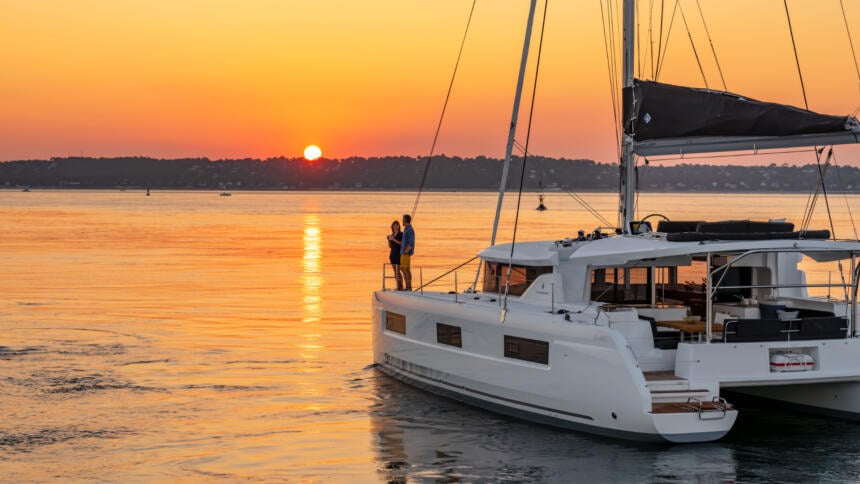
Technicalities of your sailing alone cruise
Before booking your bareboat charter in Croatia, first select the right type of boat and the right time to sail. When it comes to the type of boat, your choices are between sailing yachts, catamarans, and motor yachts. On one hand, catamarans are a great choice for comfortable and leisurely sailing. They are stable and spacious, but on the other hand, they might be a bit more difficult to maneuver single-handed. In addition, they are much pricier options for a solo traveler or a small group. Furthermore, motor yachts offer speed and convenience while also being a reasonable choice for a solo sailor. All in all, smaller catamarans (up to 43 feet) and all sailboats and motorboats are much easier to maneuver single-handedly. However, docking and anchoring are always easier when you have an extra pair of hands on board.
However, if you opt for a yacht with skipper, and/or hostess, or fully crewed, you’ll discover they can be almost invisible and have “ninja” abilities when it comes to giving you your privacy. Moreover, they tailor your route according to your wishes and requests. You’ll get to visit some of the most popular spots but avoid the crowds even in high season.
Now that we’ve covered selecting a boat, let’s go over seasons and best time for solo sailing in Croatia. Obviously, the summer months of the second half of June, July and August are considered peak season. Luckily, the climate in Croatia allows for longer off-peak seasons of good weather. For that reason, our recommendation is either pre-season from May to early June or post-season time from September to early October. Pre-season provides pleasant weather and the sea already reaching warm temperatures – warm enough for swimming. Once the summer crowds disperse, the sea remains inviting during post-season months. It should be noted that weather in the off-season can sometimes vary, so take that into account when planning your sailing trip.
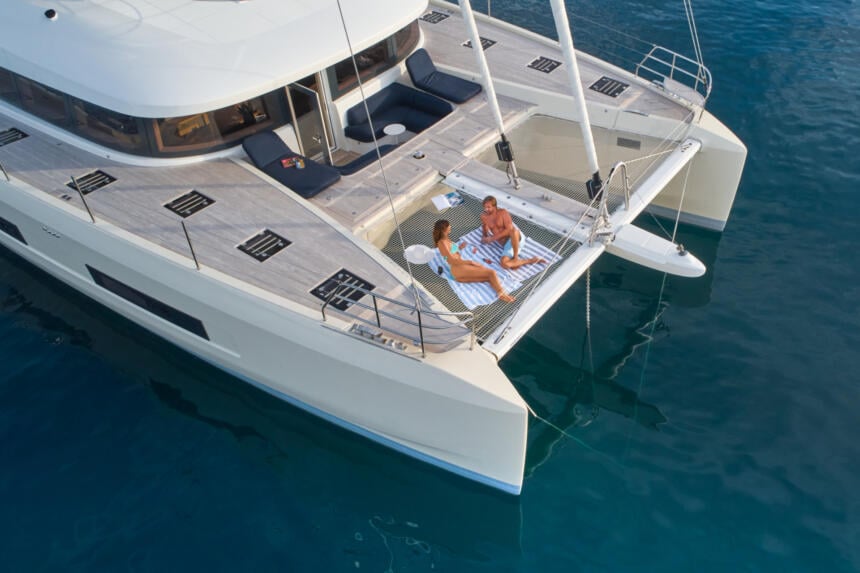
Planning your sailing alone itinerary
Croatia and the Adriatic Sea have so many islands, hidden coves, secluded beaches, and islets to visit and explore. That’s why it is important to have an itinerary, or a general idea of where you’d like to sail, before your arrival. While this blog focuses on guiding you on how to have your lone-wolf trip, it should be noted that visiting a marina occasionally (2-3 times per week) is highly recommended to charge your batteries and stock up on your boat supply.
The islands of Solta, Hvar, Lastovo, and Vis offer a maritime paradise for travelers seeking solitude, peace and relaxation. Each island has several well-equipped marinas, for the rare occasions you might need to use their services before exploring the breathtaking coastlines. The island of Solta abounds in tranquil bays and lush landscapes. It is a haven for nature lovers looking to escape the crowds. If you wish to anchor in a quiet cove, we recommend Jorja bay on the west side of the island. If you are looking for more ideas, read our blog on what to do on Solta.
Then we have Hvar, renowned for its historic charm and vibrant nightlife. However, the island and its archipelago hide numerous secluded beaches and locations where you can enjoy some peace and quiet with little to no crowds. One of those is Tiha Bay on the north-western coast of Hvar. Another one is Tarsce bay, just across Hvar to the south on the Paklenjaci islands.
Lastly, Vis and Lastovo, the most remote islands from the mainland. They captivate visitors with their unspoiled beauty and hidden coves, perfect for a quiet retreat. Our top suggestion is Zaglav bay on the south-east coast of Vis with its proximity to the island of Ravnik and the (less popular) Green Cave. Don’t forget to stop by Stoncica and Stiniva beaches. And on Lastovo, Pasadur is a must visit. While you are on Lastovo, star gazing is highly recommended. The skies there are one of the least light-polluted in all of Europe.
Whether anchoring in their marinas or discovering their fascinating shorelines, these islands promise an escape for those yearning to spend their trip in seclusion.

Embracing the solitude
Now that the locations are covered, time to switch focus to various activities you can do on your solo sailing adventure. For instance, reading, meditation, and yoga are perfect activities for those who wish to disconnect from the world. Moreover, being on a boat allows you to have different background scenery for each activity.
Last but not least, being at sea means you’re surrounded by breathtaking and “photogenic” nature. These islands are distant enough from the coast and populated areas and there is barely any light pollution. So, they are perfect spots for stargazing. Feel free to use a stargazing app for learning about stars and constellations. Observing interesting astronomical events, for instance, the tears of St. Lawrence/Perseid meteor shower in early August, or lunar eclipses and planetary alignments, are also a great way to spend your evenings.
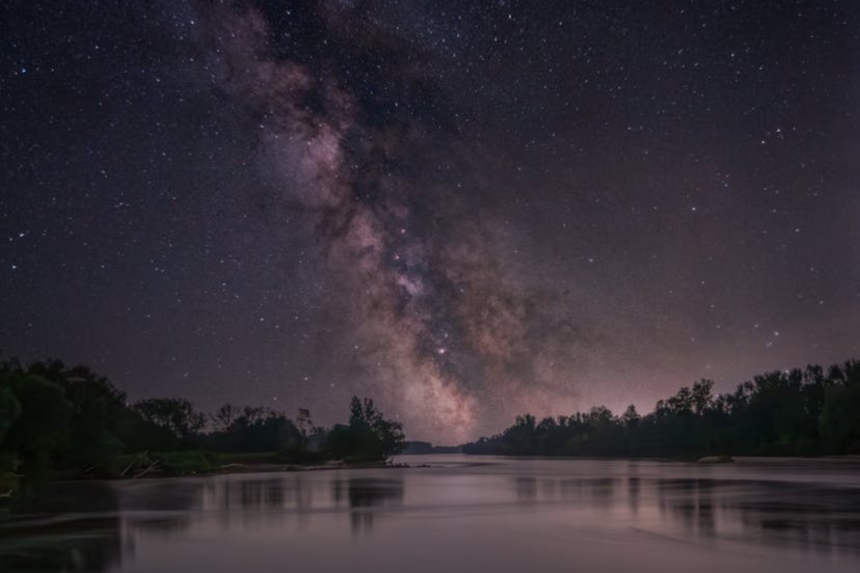
In conclusion, if you’re looking to spend your vacation in solitude, chartering a boat in Croatia with Nava is a great choice. By renting a yacht, carefully planning your itinerary, and provisioning adequately, an unforgettable solo sailing experience awaits. And it will rejuvenate your mind and soul. Here’s to sailing alone!
If this piqued your interest, feel free to reach out to our Nava Charter team. They will help you organize and plan your next sailing trip in Croatia!
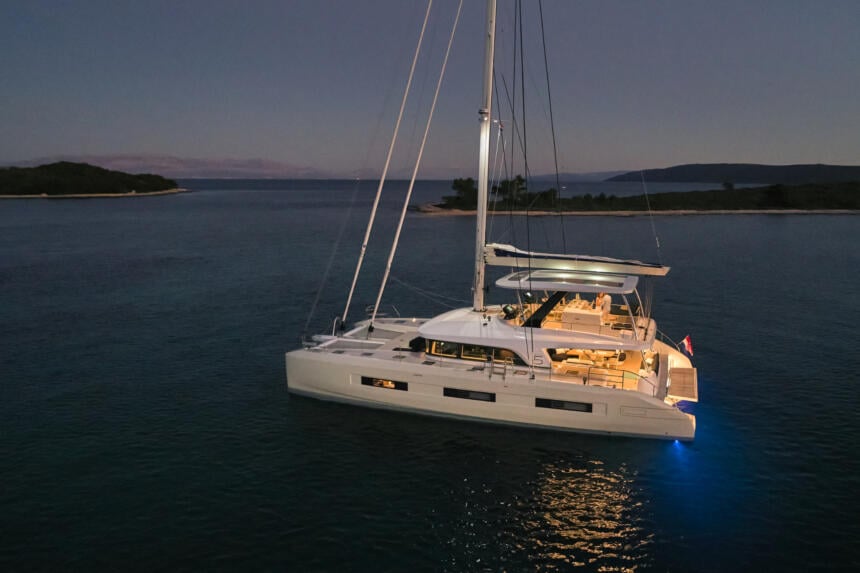
Boating tips
Find useful advice regarding sailing or our charter procedures in the “Boating Tips” section.


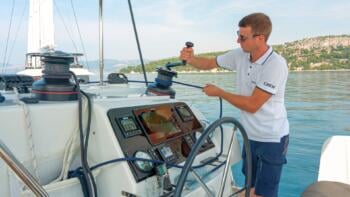
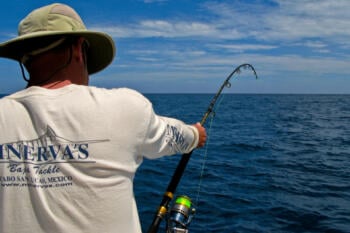
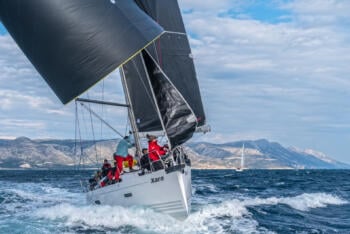





Inspiration
Decide where, when, and how to sail and what to do on or off board. Choose your lifestyle on board our top charter boats.

Book Your Perfect Charter Vacation - Lagoon 51 - Reality from Split, Croatia...
Read more





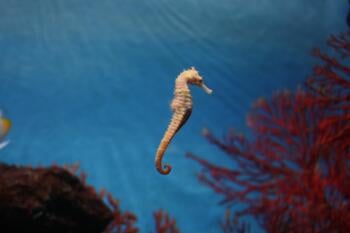
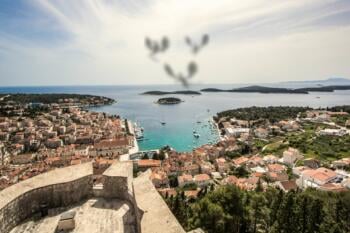
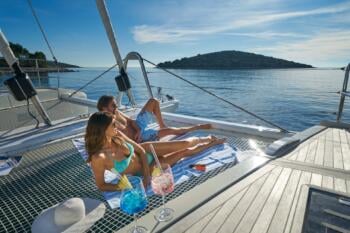
Island guide
Explore micro-insular and coastal destinations to add to your perfect sailing route in the “Island Guides” section.

The Best Snorkeling Spots in Central Dalmatia in Croatia - Hvar, Brac, Vis,...
Read more

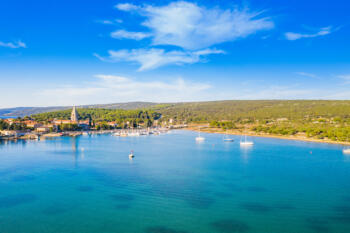
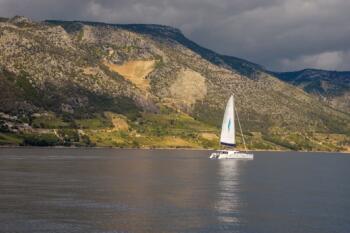
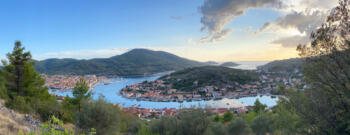
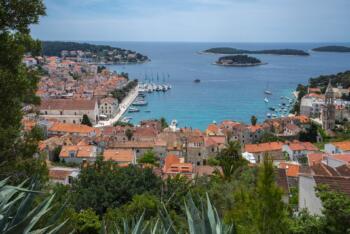
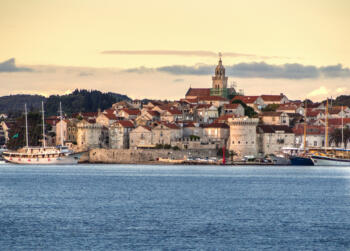
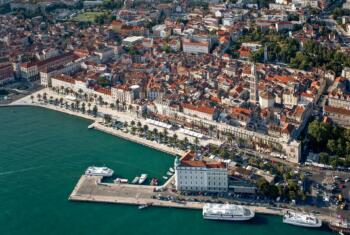
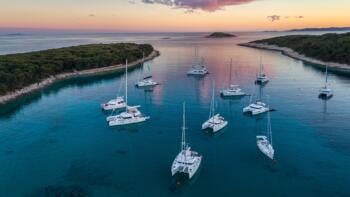
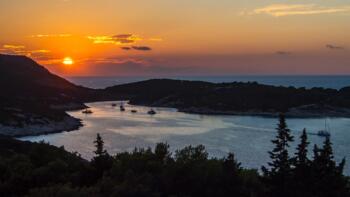
Subscribe to our Newsletter
Get latest news, offers and suggestions.
Contact
For all inquiries outside our working hours (Mon - Fri, 9 - 17 h Central European Time), please use the contact form below, or send us an email.
Got a question? We’d love to hear from you.
Send us a message and we’ll respond as soon as possible.
This boat is in !
Charter Department
Address: Obala kneza Branimira 11, Split, Croatia
Tel. +385 21 407 713
charter@navaboats.com
Sales Department
Address: Obala kneza Branimira 11, Split, Croatia
Tel. +385 21 407 700
sales@navaboats.com
Volvo Penta Center
Address: Sustipanski put 1, Split, Croatia
Tel. +385 21 315 520
volvo@navaboats.com
Aftersales
Address: Obala kneza Branimira 11, Split, Croatia
Tel. +385 21 407 720
aftersales@navaboats.com
Marketing
Address: Obala kneza Branimira 11, Split, Croatia
Tel. +385 21 407 706
marketing@navaboats.com









